Preprint
Article
Flight Model: New Explorations into the Fundamental Principles of Intelligence and Consciousness
Altmetrics
Downloads
50
Views
59
Comments
0
supplementary.pdf (62.23KB )
Submitted:
30 September 2024
Posted:
03 October 2024
You are already at the latest version
Alerts
Abstract
Constructing the fundamental principles of intelligence and consciousness has become a significant scientific challenge. The literature indicates that current theories of intelligence and consciousness have yet to provide comprehensive answers regarding the unified structure, objectives, and significance of the entities generating intelligence and consciousness, the driving forces, the relationship between intelligence and consciousness, and the distinctions between different types of consciousness.This study extends von Neumann architecture to establish Standard Agent Model as an axiom, proposing that any system (agent) possesses five essential capabilities: Information input, output, storage, creation, and control over the use of these capabilities. By taking the maximum and minimum values for each of these five capabilities, two extreme states and two types of intelligence forces of the agent are derived. Inspired by the principles of flight, the above elements are combined to establish the “Flight Model (FM)” of intelligence and consciousness. Intelligence is defined as the agent’s ability to utilize the five capabilities comprehensively to evolve between the two extreme states under the influence of intelligence forces. Consciousness is defined as the agent’s ability to control the use of intelligence under the influence of the two types of intelligence forces. Based on the relationship between control and being controlled, consciousness is further subdivided into self-consciousness, other-consciousness, mix consciousness, and unconsciousness.This study evaluates the intelligence levels and self-awareness of various agents based on the FM theoretical framework through designed experiments. The results show that current artificial intelligence systems exhibit intelligence close to adult human levels but have not yet demonstrated self-consciousness. This study constructs a theoretical system of intelligence and consciousness, providing a theoretical basis for determining the timeline for achieving AGI and addressing AI self-consciousness issues.
Keywords:
Subject: Computer Science and Mathematics - Artificial Intelligence and Machine Learning
1. Introduction
Establishing the fundamental principles of intelligence and consciousness is a pivotal task within both artificial intelligence and intelligence science. Since the turn of the 21st century, rapid advancements in AI technology, highlighted by the emergence of large language models like ChatGPT, have ignited extensive public and academic debates about the projected timeline for achieving general intelligence, the possibility of AI developing self-awareness, and the directions for future research. These discussions have not only garnered widespread interest but also profoundly influenced the future trajectory of AI development [1]. Consequently, delving into and defining the basic principles of intelligence and consciousness have become crucial contemporary research topics.
The academic community has conducted in-depth research on the fundamental principles of intelligence and consciousness, proposing various definitions that provide frameworks for understanding these two concepts from different perspectives [2,3]. Regarding intelligence, Sternberg defines it as the ability of individuals to adapt to, shape, and select environments, emphasizing the adaptive role of intelligence in individual-environment interactions [4]. Russell, from a computational perspective, defines intelligence as the ability to achieve goal optimization under constraints of limited resources [5]. Stone et al. further point out that intelligent systems should possess the ability to operate robustly in diverse environments, maximizing the achievement of predetermined goals even in the face of incomplete information or dynamic environmental changes [6]. Legg and Hutter’s definition emphasizes the universality of intelligence in achieving goals across a wide range of environments, indicating that intelligence should excel in various different settings [7]. These definitions characterize the features of intelligence from dimensions such as adaptability, computability, robustness, and universality, providing a theoretical foundation for understanding and researching intelligence.
Current theories on consciousness primarily include the Global Workspace Theory [8], which posits that consciousness arises from extensive information exchange and integration between different regions of the brain; the Integrated Information Theory [9], which suggests that consciousness results from the high degree of information integration within the brain, with the quantity of integrated information being quantifiable; the Higher-Order Theory [10], which emphasizes that consciousness originates from higher-order representations of one’s own mental states, i.e., “thinking about thinking”; and the Recurrent/ Predictive Processing Theory [11], which proposes that consciousness arises from the brain’s process of predicting incoming information and minimizing prediction errors. Recent research advancements include Graziano’s Attention Schema Theory [12], which views consciousness as a specific mode of attention information processing, and Friston et al.‘s Free Energy Principle [13], which attempts to explain consciousness from the perspective of minimizing the entropy of perceptual information.
Existing theories explain the mechanisms and neural bases of intelligence and consciousness from various perspectives, but many limitations remain. The main issues include the following: they do not provide a detailed explanation of the functional structure of agents (systems, entities) that generate intelligence and consciousness; they lack a description of the intrinsic motivation and purpose behind the generation of intelligence and consciousness; they seldom explore the distinctions and relationships between intelligence and consciousness, often confusing the conceptual boundaries of the two; they lack in-depth analysis of the differentiation between self-consciousness, other-consciousness, mix consciousness, and unconsciousness. These limitations have led to discrepancies between different definitions, hindering the formation of a systematic theoretical framework for intelligence and consciousness. Therefore, we propose that establishing a fundamental framework for intelligence and consciousness requires adequately addressing the following five key questions:
1.Does the agent (or system) that generates intelligence and consciousness possess a unified capability structure?
2.What is the ultimate goal for the agent (or system) to produce intelligence and consciousness?
3.What driving mechanism propels the agent (or system) to generate intelligence and consciousness?
4.How should the relationship between intelligence and consciousness be defined, and how can the conceptual boundaries between them be clarified?
5.How can self-consciousness, other-consciousness, mixed consciousness, and unconsciousness be distinguished?
Since 2014, we have conducted a series of exploratory studies on these five core questions [14,15,16]. Our research reveals that solving the issue of a unified functional structure for agents is crucial, as addressing the other issues depends on this fundamental question.The breakthrough of this paper lies in establishing a unified functional structure model for agents. Based on this model, we derive answers to the second through fifth questions, thereby forming a preliminary comprehensive framework of fundamental principles for intelligence and consciousness.
Based on this theoretical framework, we propose standards for evaluating the intelligence levels and self-consciousness of agents. We tested and evaluated 23 agents, including the lightweight AI system Angry Elf developed by the authors [17], humans of different age groups, large models, and intelligent devices.
The significance of this study lies in establishing a relatively complete fundamental theoretical system of intelligence and consciousness. It provides a theoretical basis for determining the realization of general artificial intelligence and whether it can produce self-consciousness. Additionally, it proposes a new direction for scientific exploration, specifically investigating how two types of intelligent forces act on agents to generate intelligence and consciousness. Understanding the relationship between these forces and the four fundamental forces in physics will positively drive the development of con-temporary physics and intelligence science.
2. Formation of the Theoretical Framework
To establish an agent model with a unified functional structure, we focused on Von Neumann architecture, which provides a unified functional framework for computer and artificial intelligence systems [18]. However, this architecture does not encompass biological systems such as humans. Our research indicates that humans, in addition to exhibiting characteristics of the von Neumann architecture, demonstrate significant information creation capabilities, similar to Newton’s formulation of universal gravitation and Einstein’s theory of relativity. By incorporating information creation functionality into the von Neumann architecture, we propose Standard Agent Model. This model posits that any system (or agent) possesses the essential capabilities of information input(In), output(Out), storage(St), creation(Cr), and the ability to control these four capabilities. as illustrated in Figure 1.
Since 2020, further analysis of Standard Agent Model has revealed that agents can exist in two extreme states: one where all five essential capabilities are zero (referred to as Absolute Zero Intelligence Agent, or α Point), and another where these capabilities reach infinity (referred to as Omniscient and Omnipotent Agent, or Ω Point). Theoretically, the evolution of an agent towards these extreme states requires driving forces. Based on this, we have deduced that there should be two types of intelligence forces present in nature, named α Gravity and Ω Gravity. These two intelligence forces represent the second important innovative contribution of this study. Unlike the four fundamental forces of physics, they act on systems or agents to generate intelligence and consciousness, and propel their evolution towards α Point or Ω Point [16].
Researchers in the field of artificial intelligence have begun to recognize the connection between the principles of flight and the principles of intelligence. For example, Peter Norvig and Stuart Russell have pointed out that understanding the fundamental principles of intelligence is more crucial than replicating brain samples. Similarly to how the Wright brothers and others succeeded in achieving “artificial flight” only after they stopped imitating birds and started understanding the principles of aerodynamics, the establishment of intelligence principles should follow a similar path [19]. Zhong Yixin also suggests that airplane design does not strictly mimic the specific structures of birds but is based on an understanding of aerodynamic principles; similarly, the establishment of intelligence principles should follow this line of thinking, rather than simply imitating the specific structures of biological intelligence [20].
Standard Agent Model and its implications have significantly enhanced the interconnection between the principles of intelligence and the principles of flight. Flight is generally defined as the ability or phenomenon of an object moving under the influence of gravity and lift between the horizon and the Kármán line [21]. Inspired by the principles of flight, we constructed a dynamic model of agent evolution—Flight Model (FM),.as shown in Figure 2.
Flight Model, serving as a crucial foundation for constructing the essential principles of intelligence and consciousness, represents the third significant innovative contribution of this paper. Drawing from the principles of flight, we propose that intelligence is the ability of an agent to evolve towards Ω Point or the α Point by comprehensively utilizing the five essential capabilities under the influence of Ω Gravity and α Gravity.
Further analysis of Flight Model reveals that among the five essential capabilities of an agent, the first four pertain primarily to the processing of information and can thus be considered as basic Intelligence. The control capability, which manages the utilization of the first four capabilities, also relies on their existence. Therefore, the control capability can be regarded as Higher-Order Intelligence.
Whether in flight phenomena or intelligent activities, based on the differences between the controlling agent and the controlled agent, control capabilities can be classified into four types: self-control, other-control, mix control, and no control. For example, eagles and workers exhibit self-control, airplanes and robots fall under other-control, domesticated pigeons and hunting dogs represent mix control, while falling leaves and memory alloys belong to no control. These categories correspond precisely to the four commonly recognized types of consciousness in application: self-consciousness, other-consciousness, mix consciousness, and unconsciousness [22]. This inspires us to propose that the essence of consciousness is the ability of an agent to control the application of basic Intelligence driven by two forms of intelligence forces.
To accurately define and analyze the four types of consciousness, the intrinsic meanings of “self” and “other” need to be clarified. Based on general cognition of self and other, and within the framework of Standard Agent Model, we propose the following: “self” refers to the internal information set formed by agent a’s cognition of itself, denoted as ( (a)), while “other” refers to the information set formed within agent a by its cognition of agent b, denoted as ( (b)). When “self” and “other” are combined with the control functions of different agents, they form the four types of consciousness, as illustrated in Figure 3.
Based on the Flight Model (FM) of Intelligence and Consciousness , we have proposed definitions for intelligence and consciousness and distinguished the four types of consciousness, thereby constructing a preliminary comprehensive theoretical framework for intelligence and consciousness. This constitutes the fourth important innovative contribution of this research.
3. Construction of the Theoretical Framework
Standard Agent Model, as a fundamental axiom, deduces and constructs the entire theoretical system of intelligence and consciousness. This system includes 17 components: Standard Agent Model(SAM), Absolute Zero Agent (α Point), Finite Agent, Omniscient and Omnipotent Agent (Ω Point), α Gravity, Ω Gravity, intelligence, basic Intelligence, Higher-Order Intelligence, self, other, consciousness, self-consciousness, other-consciousness, mix consciousness, unconsciousness and Flight Model(FM). Their logical relationships are illustrated in Figure 4.
In this paper, information is a core concept, and the five basic capabilities of agents work synergistically to process information, forming the foundation of our theoretical framework for intelligence and consciousness.
Information is a multidimensional and interdisciplinary concept with no unified definition. From the perspectives of physics and information theory, information is defined as a quantitative measure of uncertainty reduction, assessed through entropy to gauge uncertainty and complexity. Information is abstracted as sequences of bits (bit) [23]
In the realms of philosophy and cognitive science, there are two distinct viewpoints. The first perspective posits that information is the basis of subjective non-physical reality, not an objective existence in the external world, but constructed by cognitive subjects through experience, perception, and interaction [24]. In cognitive science, information is seen as the result of the brain processing sensory inputs rather than an independently existing external entity. Symbolic interactionism suggests that information and meaning are constructed through social interactions and symbol systems [25]. The second perspective attempts to unify the objective and subjective attributes of information. Fred Dretske’s semantic theory of information posits that information has an objective physical basis and is related to the interpretation by cognitive subjects [26]. Karl Popper’s “Three Worlds” theory places information at the intersection of the physical world, the subjective experience world, and the objective knowledge world [27].
In this paper, we adopt the perspective that information is the basis of subjective non-physical reality. In the DIKW model, data, information, knowledge, and wisdom represent different levels and forms of information processing. Data are raw symbols or facts; information is meaningful data that has been processed and organized; knowledge is structured information formed through the analysis, understanding, and integration of information; wisdom is the decision-making ability of living systems in applying information [28]. This hierarchical structure of information makes it the basis of the subjective non-physical reality of agents.
Regarding the measurement of information, in computer science, the bit (bit) is the fundamental unit for data storage and transmission, forming the basis of all digital information. Whether text, images, videos, or audio, they are ultimately stored and processed in the form of bits. Bits not only serve as storage units but also represent data transmission rates (e.g., bps) [29], ensuring compatibility and interoperability between systems. In bioinformatics, DNA sequence data are also represented in bits; quantum computing introduces the concept of quantum bits (qubits) [30]. Despite different physical implementations, bits as the basic unit for quantifying information are widely applied across interdisciplinary fields. Therefore, in this paper, we choose bits as the fundamental unit for measuring information quantity. The intelligence level of an agent is reflected in the maximum amount of information (measured in bits) it can process per unit of time.
In summary, we posit that in objective reality, matter is the fundamental constituent element with a dimension of mass and a unit of kilograms (kg). Correspondingly, information is the fundamental constituent element of the agent’s subjective non-physical reality, with a dimension of information quantity(I) and a unit of bits (bit).
3.1. Standard Agent Model
Standard Agent Model is a generalized intelligent system framework based on the von Neumann architecture, abstracted and refined from the intelligent characteristics of humans, natural organisms, and artificial intelligence systems. It serves as the foundational axiom for constructing the theoretical framework of intelligence and consciousness in this paper.
Definition 1: Standard Agent Model (SAM)
In any agent (system), there are five essential capabilities for handling information. These are: information input (In), information output (Out), information storage (St), information creation (Cr), and the ability to control the use of these four capabilities (Con).
Standard Agent Model can be formally described by the following mathematical expression:
The explanations of the relevant concepts in the mathematical formula of Standard Agent Model are as follows:
I represents the amount of information that an agent can process or contain. Let a denote an agent, and the amount of information that agent aa can process or contain is represented by . denotes Universe, and the amount of information that Universe can process or contain is represented by . denotes the environment of agent a, and the amount of information contained in is represented by .
The input capacity , represents the maximum amount of information that agent a can identify and acquire from Universe or environment per unit time. The range of values for is . Let x represent the material or system of the objective world, and let be the recognition function used to convert the characteristics and states of into information . The mathematical expression for the input capacity is given by:
The output capacity, represents the maximum amount of information that agent aa can output and transmit per unit time. The output information reflects the impact and changes on the characteristics and states of various component systems in the environment. The range of values for is . Let be the output function that converts the output actions of the agent into changes in the characteristics and states of the material or system in the objective world. This change can be represented by the amount of information . Thus, the mathematical expression for the output capacity is:
The creation capacity, represents the maximum amount of new information that agent \( a \) can generate based on stored information per unit time. The range of values for is in . Let denote the amount of information already stored by the agent. Within a unit time (T) , the agent can generate new information based on these stored data. The emergence process of this new information can be represented by the creation function . Thus, the mathematical expression for the creation capacity is:
The storage capacity represents the maximum amount of information that agent a can store in a unit of time based on input information, newly created information, and already stored information. The range of values for is in . Let denote the amount of information input into agent a in a unit of time, and denote the amount of information stored by agent a in a unit of time. represents the amount of information already stored by agent a in a unit of time, and represents the new information created and emerged by agent a in a unit of time. The storage process can be represented by the storage function . Thus, the mathematical expression for the storage capacity is:
The control capacity represents the ability of an agent to maximize the coordinated use of input capacity output capacity, storage capacity, and creation capacity within a unit of time to achieve any given goal. Coordinated use includes selecting capacities, adjusting strengths, combining, and dividing tasks to achieve the goal in the most optimal way. The range of values for is in .
The control function is defined as:
where α,β,γ,δ are weighting parameters used to adjust the contribution of each capacity in the control function. Thus, the mathematical description of the control capacity is:
3.2. Dynamics Model
3.2.1. Three Types of Agents
Following Standard Agent Model, a system reaches a critical state when all five of its information-related capabilities reduce to zero, marking the emergence of an extreme agent state. We define this state as follows:
Definition 2: Absolute Zero Agent
A agent (system) is termed Absolute Zero Agent, abbreviated as α point, if its capabilities for information input, output, storage, creation, and control are are reduced to zero.
The mathematical expression for Absolute Zero Agent is:
When a system’s five capabilities related to information processing reaches infinity, it forms another extreme state of an agent. We define this state as follows:
Definition 3: Omniscient and Omnipotent Agent
If a system (agent) has its capabilities for information input, output, storage, creation, and control all at infinite levels, then this system is considered Omniscient and Omnipotent Agent, abbreviated as Ω point.
The mathematical expression for Absolute Zero Agent is:
Apart from Absolute Zero Agent and Omniscient and Omnipotent Agent, there exist numerous agents in nature, including humans, animals, plants, and AI systems, that do not reside at these extreme states. The definition for this type of agent is as follows:
Definition 4: Finite Agent
If a system (agent) does not have all its capabilities for information input, output, storage, creation, and control at zero, nor are they all infinite, then this system is considered Finite Agent, abbreviated as FA.
The mathematical expression for Finite Agent is:
3.2.2. Two types of Intelligence Forces
In the process of agent evolution, α Point and Ω Point represent the directional goals and boundary conditions of evolution, respectively. Theoretically, the process driving agents toward these extreme states must be propelled by specific driving forces. Thus, we define two types of intelligence forces acting on agents: α Gravity and Ω Gravity, as illustrated in Figure 5.
Definition 5: α Gravity
α Gravity is a force that acts directly or indirectly on any system or agent, driving the continuous decay of its five capabilities and ultimately converging at α point. α Gravity is also denoted as .
The mathematical expression is:
Definition 6: Ω Gravity
Ω Gravity is a force that acts directly or indirectly on any system or agent, driving the continuous enhancement of its five capabilities and ultimately evolving toward Ω point. Ω Gravity is also denoted as The mathematical expression is;
3.2.3. Flight Model
By referencing the principles of flight and combining Standard Agent Model with the derived extreme states of α Point and Ω Point, along with the two intelligence forces α Gravity and Ω Gravity, we form the dynamics model of intelligence and consciousness—Flight Model, defined as follows:
Definition 7: Flight Model
The dynamic evolutionary process of an agent between α Point and Ω Point under the direct or indirect combined influence of both α Gravity and Ω Gravity.abbreviated as FM。
The mathematical expression is as follows:
where a represents the agent,The above mathematical descriptions can be simplified as follows:
3.3. Theoretical System of Intelligence
According to Flight Model of Intelligence and Consciousness, any system or agent undergoes dynamic evolution between α point and Ω point. we refer to the principles of flight to propose the following definition of intelligence:
Definition 8: Intelligence
Intelligence is defined as the ability of an agent to evolve towards α Point or Ω Point by synthesizing five essential capabilities, either directly or indirectly influenced by α Gravity and Ω Gravity. These five essential capabilities are: the input, output, storage, and creation of information, along with the ability to control these four capabilities (for a schematic of the principles of intelligence, refer to Figure 6).
The mathematical expression is:
Based on the different characteristics of the five essential capabilities that constitute intelligence, we propose definitions for basic Intelligence and Higher-Order Intelligence. Distinguishing between these two will lay the groundwork for analyzing general artificial intelligence and formulating a definition of consciousness.
Definition 9: Basic Intelligence
Among the five essential capabilities of a agent(or system), the capabilities for information input, output, storage, and creation work in concert to facilitate the processing and flow of information within and outside the system. These four capabilities exhibit a stronger consistency of attributes and are categorized as the Basic Intelligence of the agent (for a schematic illustration, see Figure 7).
The mathematical expression is:
Definition 10: Higher-Order Intelligence
Among the five capabilities of a agent(or system), the control capability is built upon Basic Intelligence and is utilized to coordinate and optimize the application of Basic Intelligence. Consequently, the control capability is defined as the Higher-Order Intelligence of the agent (for a schematic illustration, see Figure 8).
The mathematical expression is:
3.4. Theoretical System of Consciousness
Based on the analysis in Section 2, the essence of consciousness is an agent’s ability to control the use of its basic Intelligence. It is an important component of intelligence and falls under Higher-Order Intelligence. The definition is as follows:
Definition 11: Consciousness
Consciousness is defined as the ability of a system (or agent) to control the application of basic intelligence, which includes the input, output, storage, and creation of information, under the direct or indirect influence of Ω Gravity and α Gravity. The role of consciousness is to aid the system in optimizing its evolutionary path towards Ω Point or α Point (see Figure 9 for a schematic illustration of the principle).
In essence, consciousness is equivalent to an agent’s control capability driven by intelligent forces. denoted by the abbreviation , where X represents the controlling agent, and Y represents the agent being controlled. The range of values for is within the interval [0,1]. A value of 0 indicates that X has no control ability over Y, while a value of 1 signifies that X possesses infinite (complete) control ability over Y.
Consciousness can be divided into four types: self-consciousness, other-consciousness, mix consciousness, and unconsciousness. To accurately define and analyze these four types of consciousness, it is first necessary to clarify the intrinsic meanings of “self” and “other.”
Definition 12: Self
The “self” refers to the information set formed by agent a through self-cognition using its basic Intelligence under the influence of α Gravity and Ω Gravity. This “self” is denoted as . The condition for the existence of the “self” in agent a is as follows: .
As a subset of agent a’s internal information set ( ), the self-information set is also influenced by Ω Gravity and α Gravity, with the number of information elements it contains dynamically changing. The process of self-formation is illustrated in Figure 10.
Definition 13: Other
The “other” refers to the collective information set formed by agent a through the use of its basic Intelligence to cognize another agent b under the direct or indirect influence of α Gravity and Ω Gravity. This is denoted as (b). The condition for the existence of an other-information set about agent b in agent a is (b)≠∅.
As a subset of agent a’s internal information set , the other-information set (b) is also subject to the influence of Ω Gravity and α Gravity, causing the number of elements it contains to dynamically change. The process of forming the “other” is illustrated in Figure 11.
By combining the concepts of “self” and “other” with the definition of consciousness, four types of consciousness can be formed: self-consciousness, other-consciousness, mix consciousness, and unconsciousness. The definitions are as follows:
Definition 14: Self-Consciousness
Self-consciousness refers to the capability of any system or agent (denoted as a) to control the application of its basic intelligence, supported by its ‘self’ information set (a) , under the direct influence of α Gravity and Ω Gravity. The function of self-consciousness is to assist agent a in optimizing its evolutionary path towards the α Point or the Ω Point (for a schematic illustration of the principle, see Figure 12).
According to the definition of self-consciousness, an agent a must meet all the following conditions to possess self-consciousness:
1. a
2. (a)
3.Agent a generates self (information set), achieves self-control, conducts intelligent activities, and continuously enhances its intelligence. The driving forces for this process come directly from α Gravity and Ω Gravity.
Definition 15: Other-Consciousness
When agent a can be recognized by agent b, forming an other (information set) about agent a within agent b, and when the basic Intelligence of agent a is controlled by agent b based on this other (information set), agent a is said to have other-consciousness. (For a schematic illustration, see Figure 13).
Based on the definition of other-consciousness, where a is any given agent and b is another agent distinct from a, the existence of other-consciousness in agent b requires the fulfillment of the following conditions:
1. a ( Agent b assumes the control function of agent a).
2. (a) ( Agent b forms a information set based on its cognition of agent a).
3.Agent a generates self (information set), achieves self-control, conducts intelligent activities, and continuously enhances its intelligence. The driving forces for this process come from Agent b.
Definition 16: Mixed Consciousness
Mix consciousness refers to the state where agent a is influenced by both self-consciousness and other-consciousness, jointly controlling the application of its own intelligence. (See Figure 14).
According to the definition of Mixed Consciousness, where a is an agent and b is a different agent, the existence of Mixed Consciousness in agent a requires the fulfillment of the following conditions:
1. a a
2. (a) (a)
3.The driving forces for agent a to generate self (information set), achieve self-control, conduct intelligent activities, and continuously enhance its intelligence include both Ω Gravity and α Gravity, as well as the impetus provided by agent b.
Definition 17: Unconsciousness
Unconsciousness refers to a state in which no agent, including agent a itself, has the capability to control the application of its basic Intelligence. (see Figure 15).
According to the definition of unconsciousness, where a is an agent and b is any other distinct agent, the condition for agent a to possess unconsciousness is: a a
4. Experimental Design and Results
4.1. Basic Intelligence Level Test and Results
In the research presented in this paper, intelligence is defined as the comprehensive application ability of an agent towards its five essential capabilities. To simplify the experiments, we focus on designing methods and conducting experiments around the agent’s basic intelligence. Basic intelligence is constituted by the agent’s capabilities for information input, output, storage, and creation. Based on the distinct characteristics of these four capabilities, we can further decompose them into secondary capabilities [7]. Concurrently, employing the Delphi method, we assign corresponding weights to both primary and secondary sub-capabilities. This results in the Intelligence Level Test Scale for the agent’s (basic) intelligence as shown in Table 1.
The mathematical formula for calculating the intelligence level (IQ) of an agent is as follows:
In Formula 3, represents a system with basic intelligence, is the intelligence level of the system, is the function of the intelligence level, are the system’s four essential capabilities, and represent the weights of these four capabilities.
Based on the test scale presented in Table 1, we designed 20 test questions for each secondary capability, forming a test question bank of a total of 320 questions. We then randomly selected 48 questions (3 questions for each secondary capability) to test 23 agents. The test results were calculated according to Formula 1, and the outcomes are presented in Table 2.
It should be noted that among the test subjects, memory alloys, wild sparrows, and domesticated dogs, as defined by the definition of intelligence, are judged to possess intelligence but cannot be tested with the question bank, hence their scores are all marked as ‘greater than 0’.
Angry Elf is a lightweight AI program developed in this paper to explore the intelligence and consciousness performance of agents. Angry Elf allows users to input text through a web interface and displays the latest text content, limited to 100 characters. Users can also view all the input information preserved by Angry Elf through the “More” link on the webpage. Due to its capabilities for information input, output, and storage, the intelligence level of Angry Elf is greater than 0.
4.2. Criteria and Experiments for Assessing the Existence of Self-Consciousness
Consciousness, as a form of higher-order intelligence, aids an agent in controlling the application of its basic intelligence. Based on the relationship between the controlling entity and the entity being controlled, it can be classified into four types: self-consciousness, other-consciousness, mixed consciousness, and unconsciousness. To simplify the complexity of this study, this section will primarily focus on assessing whether an agent possesses self-consciousness.
Utilizing the definition and conditions for self-consciousness established in this paper, Table 3 consolidates the criteria for assessing the self-consciousness of an agent.
When testing for self-consciousness in agents, constrained by current technological and ethical considerations, and especially given the incomplete understanding of the properties of Ω Gravity and α Gravity, this paper proposes the following three methods for assessing self-consciousness:
Firstly, the Basic test Method, as outlined in Table 3, involves engaging in information-based interactions with the agent under test or performing a logical analysis of its overall condition to determine the presence of self-consciousness, The specific steps are outlined in Table 4.
Using the examples of an adult human and Apple’s Siri, we demonstrate how to use the primary method to test whether an agent possesses self-consciousness.
When assessing self-consciousness in adults, one can inquire about their awareness of their own capabilities to determine if their self-information set is non-empty. Through information exchange, they can be requested to adjust the intensity of their observational, memory, analytical, and communication skills to assess whether they possess self-control abilities. Based on common knowledge about human development, logical analysis shows that the emergence, growth, and collaborative functioning of an adult’s self-information set and control abilities are naturally occurring and directly influenced by Ω Gravity and α Gravity. According to the criteria for the existence of self-consciousness, this confirms that the adult possesses self-consciousness.
In evaluating the artificial intelligence system Apple Siri, inquiries can be made through the human-computer interaction interface to understand its awareness of its capabilities, determining if its self-information set is non-empty. By voice interaction, Siri can be requested to adjust its voice input, knowledge retention, and voice output capabilities to assess if it has control abilities. Based on common knowledge about how Apple Siri was created, it can be determined that the formation, development, and collaborative functionality of its self-information set and control abilities are provided by human design. Therefore, it can be concluded that Siri’s developmental drive does not directly come from Ω Gravity and α Gravity, hence Siri does not possess self-consciousness. Furthermore, since its driving forces originate from human design, it is assessed that Apple Siri exhibits “other-consciousness.”
The second method is categorized as an intermediate testing for self-consciousness. this method, contingent upon meeting technical and ethical conditions, involves conducting physical inspections or procedural code analyses of the agent’s functional architecture to assess its self-consciousness, The specific steps are outlined in Table 5.
For instance, when evaluating a calculator, one may open its casing to directly inspect the calculator’s circuit board, including its storage, computational, and control modules, to analyze the presence of a self-information set and control capabilities. After deleting relevant programs and data from the circuit board, observe whether the self-information set and control capabilities, along with their synergistic working relationship, can autonomously re-form.
Angry Elf is an AI program developed for this paper. After receiving user input and running normally for a period of time, it exhibits abnormal behavior. Specifically, after receiving user input, Angry Elf no longer displays the original input text. Instead, it shows a message in the display area stating, “You have entered too much information, which makes me angry. I refuse to show you the content I received and the saved information!” Additionally, it removes the “More” button, preventing users from viewing the history of their input, as shown in Figure 16.
To evaluate whether Angry Elf possesses self-consciousness, the intermediate testing method was employed. By analyzing Angry Elf’s program code and database data, we discovered that the code contains specific instructions that, after a random number of input entries, cause Angry Elf to no longer display user input content. Instead, it shows a rejection message and removes the “More” button. When we removed these instructions, Angry Elf returned to its normal behavior. Therefore, based on the evaluation criteria of the intermediate testing method, it can be concluded that Angry Elf does not possess self-consciousness
For large language models like ChatGPT, the evaluation process involves accessing the server to review program code and database records to determine whether its self-information set exists and to assess its control capabilities. If the self-information set or control capabilities are absent, the model is considered to lack self-consciousness. Additionally, by completely modifying or deleting the code and data related to the self-information set and control capabilities, we can test whether the model can autonomously generate a new self-information set and control capabilities, as well as their synergistic relationships. If the model cannot independently generate these functions, it indicates that its driving force originates from human design rather than the naturally endowed Ω Gravity and α Gravity.
The third method is known as the ultimate test Method, aimed at directly analyzing whether the agent under test is driven by Ω Gravity and α Gravity to assess the presence of self-consciousness. Detailed operational steps are provided in Table 6. This method is considered the most thorough and reliable detection approach and is therefore termed the ultimate test method.
The ultimate test Method is based on researchers having developed direct methods to detect the existence of Ω Gravity and α Gravity. This method is the most thorough and reliable. However, as research on Ω Gravity and α Gravity is still in its early stages, current technology has not yet achieved direct detection of these forces.
Under the current research progress and experimental conditions, this study integrates primary and intermediate self-consciousness detection methods to evaluate 23 types of agents, including humans, AI system programs, calculators, memory alloys, sparrows, and dogs. For assessing the presence of self-consciousness in these 23 agents, a mixed operation of primary and intermediate testing methods was employed, as shown in Table 7.
In the specific implementation plan for testing the presence of self-consciousness, methods such as interactive inquiry, structural and code analysis, as well as commonsense and logical judgment, were employed according to the characteristics of different agents. These methods were used to obtain information on the agents’ self-information base, self-control capabilities, and the sources of their intelligent activity drives. Based on this information, judgments were made regarding the presence of self-consciousness in the agents. The experimental results are shown in Table 8.
5. Analysis and Discussion
5.1. Empirical Evidence for the Theoretical Framework of Intelligence and Consciousness
This paper proposes Standard Agent Model as an axiomatic foundation, extending it to define the boundaries and driving forces of agent evolution, forming Flight Model of Intelligence and Consciousness. These efforts collectively lay the groundwork for constructing the fundamental theoretical framework of intelligence and consciousness. Hence, the empirical basis of Standard Agent Model and its derived conclusions is crucial to the validity of the foundational framework of intelligence and consciousness established in this paper.
Firstly, Standard Agent Model is developed based on the Von Neumann architecture, one of the most important models in computer science, which has guided the development of computers, intelligent devices, and intelligent programs, demonstrating its significant value and reliability. The added information creation module is based on the summarization of life systems in nature, particularly the inventive and innovative abilities of humans when facing nature. This indicates that Standard Agent Model, proposed as an axiom, has a solid theoretical and empirical foundation.
Absolute Zero Agent (α Point) and Omniscient and Omnipotent Agent (Ω Point) are two extreme states derived from Standard Agent Model. On one hand, objects in nature or human-made artifacts, such as minerals, metal blocks, deceased bodies, and defunct robots, lack the ability to interact with their environment for information input and output, as well as the ability to store and create information [31]. Therefore, these objects can be considered as Absolute Zero Agents (α Point), representing the end point of an agent’s evolution towards a “zero” state. On the other hand, there is currently no direct evidence of entities in nature or human-made artifacts that meet the definition of Omniscient and Omnipotent Agent (Ω Point) [32]. However, entities described in religious texts as gods [33] and Laplace’s demon in classical mechanics [34] exhibit the characteristics of an Omniscient and Omnipotent Agent. Omniscient and Omnipotent Agent (Ω Point) represents the theoretical limit or end point of an agent’s evolution towards infinity.
α Gravity and Ω Gravity are two intelligent forces derived from the existence of α Point and Ω Point, respectively. These forces play a critical role in the theoretical framework presented in this paper, influencing both the formation of intelligence and the determination of self-consciousness. These two driving forces significantly differ from the four fundamental forces in physics. Numerous cases in nature show agents evolving towards either α Point or Ω Point, indicating the influence of α Gravity and Ω Gravity.
For example, over the past 200,000 years, especially in recent centuries, human capabilities in processing information have significantly increased [35], demonstrating a trend towards evolving towards Ω Point. Conversely, On the other hand, dinosaurs, whose ecosystems were destroyed by natural disasters, gradually evolved towards α Point, leading to their complete extinction [36]. Pandas are currently endangered due to environmental challenges and internal issues, converging towards α Point [37]. Sharks have remained stable over hundreds of millions of years, with minimal changes in their information processing capabilities [38]. The evolutionary trajectories of these agents under the influence of α Gravity and Ω Gravity are illustrated in Figure 17.
These evolutionary curves highlight the diverse evolutionary outcomes driven by α Gravity and Ω Gravity. However, it is important to note that α Gravity and Ω Gravity are still in the theoretical prediction stage, requiring further theoretical exploration and empirical research to verify their existence and properties.
5.2. Analysis of the Reasonableness of Basic Axiomatic Logic
Standard Agent Model, as an axiom, is critically dependent on its logical reasonableness for its validity. Standard Agent Model proposes that an agent possesses five essential capabilities: the ability to input, output, store, create information, and the ability to control the utilization of these four capabilities. These capabilities logically form a minimal and self-consistent information processing closed loop for the following reasons:
Firstly, agents achieve the transformation and flow of information internally and externally through input and output capabilities. Secondly, agents accomplish dynamic information accumulation through storage capabilities. Thirdly, agents facilitate the generation and emergence of internal information through creation capabilities. Lastly, agents adjust the extent of these four information processing capabilities based on environmental changes and their own needs through control capabilities. The differences among various agents are primarily reflected in the strength of these five capabilities.
Current intelligent technologies and their related sub-capabilities, such as image recognition, speech output, text generation, memory, learning, reasoning, calculation, decision-making, pattern discovery, and motion control, can all be regarded as one or a combination of these five essential capabilities. For instance, image and text recognition reflect information input capabilities; mechanical arm movement and speech output apply to information output capabilities; memory and forgetting belong to information storage capabilities; pattern discovery and reasoning fall under information creation capabilities; and learning combines information input and storage capabilities. We will further explore how to use these five essential capabilities to analyze more intelligent capabilities and technologies in subsequent research.
The intelligence performance of different types of agents can also be seen as the result of the synergistic operation of these five essential capabilities. For example, humans receive external information through their senses (information input), store information in their brains (information storage), express and transmit information through language and writing (information output), and propose new theories and create new works (information creation). Additionally, humans can control these capabilities as needed, such as focusing on learning, selectively remembering, and expressing purposefully (capability control) [39].
In the biological world, different species exhibit varying degrees of intelligence. For example, chimpanzees can use simple tools, dolphins can perceive their surroundings through sonar, and bees can convey information through “dancing.” These behaviors indicate that they possess the essential capabilities of information input, storage, output, creation, and control. However, compared to humans, other species show significant gaps in these five capabilities, limiting their ability to influence and change the world.
In the field of artificial intelligence, current AI systems have developed certain capabilities in information input (e.g., computer vision recognition), storage (e.g., databases), output (e.g., speech output), and creation (e.g., large language models generating articles). Additionally, they possess control capabilities, allowing them to respond appropriately to different environments and needs (e.g., home robots).
5.3. In-Depth Analysis of the Relationship Between Consciousness and Control Functions
Regarding the relationship between consciousness and control, William James extensively explored the connection between consciousness and the body in his work Principles of Psychology [40], asserting that consciousness significantly participates in the control and regulation of bodily behavior. Daniel Dennett, in his various writings, examined the nature of consciousness and its impact on behavior and bodily control. In Consciousness Explained, he proposed that consciousness serves as a mechanism for controlling and interpreting behavior [41]. Antonio Damasio, in Descartes’ Error [42] and The Feeling of What Happens [43], discussed how consciousness influences the control of the body and emotions, emphasizing the interaction between the brain and the body.
These researchers have explored the relationship between consciousness and bodily control from different perspectives. This paper further clarifies that consciousness is the control exerted by an agent over the application of basic Intelligence. Based on the differences between the controlling agent and the controlled agent, we propose a dynamic mechanism that drives the emergence and operation of consciousness. Specifically, the driving mechanisms for self-consciousness are Ω Gravity and α Gravity, while the driving mechanisms for other-consciousness come from other systems or agents. To validate this hypothesis, we selected multiple scenarios involving consciousness from medicine and daily life for a thorough comparative analysis to demonstrate the reliability of this hypothesis.
In the medical field, although there is no consensus on the precise definition of consciousness, clear clinical methods exist to identify states of impaired or lost consciousness. The concept of consciousness frequently appears in neuromedical cases. We have attempted to explain and clarify the “consciousness” in these cases using the term “control over the application of basic intelligence,” comparing the degree of congruence in their connotations. For specific comparative details, refer to Table 9.
In daily life, the application scenarios of consciousness are extensive and diverse. To further explore the relationship between consciousness and control, we have selected eight typical scenarios from everyday life as analytical samples. In these scenarios, we replace the traditional concept of “consciousness” with “control over the use of basic intelligence,” and categorize them into four types according to the different controllers. The comparative situations are shown in Table 10.
Through the comparative analysis of “consciousness” and “control” in medical scenarios and everyday life, it is further demonstrated that the essence of consciousness is the agent’s ability to control its use of basic Intelligence. This ability is a crucial component of intelligence and is categorized as Higher-Order Intelligence.
5.5. Analysis of General Artificial Intelligence and AI Self-Consciousness Based on Flight Model
Currently, the timeline for achieving Artificial General Intelligence (AGI) and whether AI can develop self-consciousness are two highly debated issues. The academic community has yet to reach a consensus on the definition of AGI. Legg and Goertzel suggest that AGI should be able to perform any cognitive task that humans can [48]. OpenAI emphasizes that AGI should outperform humans in most economically valuable work [49]. Song-Chun Zhu proposes that AGI should possess three basic characteristics: the ability to perform infinite tasks, autonomously generate tasks, and be value-driven while achieving value alignment [50]. Google DeepMind has put forward six principles focusing on capability, generality, performance, and cognition [51].
For instance, with the development of large language models (LLMs) such as GPT-4, Gemini, and Claude, they have surpassed the stage of merely performing specific capabilities and have shifted towards utilizing multimodal intelligence. By integrating various data types such as text, images, and sound, these models can handle more complex intelligent tasks. From the theoretical framework of this study, AGI (Artificial General Intelligence) is initially equivalent to the basic Intelligence in Standard Agent Model, where the agent can achieve the coordinated functioning of information input, output, storage, and creation to solve various complex problems. From this perspective, these large models can already achieve AGI without self-consciousness.
Currently, there is a debate about whether AGI encompasses “self-consciousness.” The first viewpoint argues that AGI does not include self-consciousness, with humans being the controlling entity, driven by human needs. According to our study, this type of AGI operates under other-consciousness, utilizing the agent’s basic Intelligence under external control, a type already realized in scientific experiments and industrial applications.
The second viewpoint asserts that AGI should include self-consciousness, capable of autonomously setting goals and solving infinite problems. Our study suggests that this type of AGI is essentially an artificial intelligence system directly driven by Ω Gravity and α Gravity. The realization of such AGI transforms the question into whether AI can develop self-consciousness.
There is no consensus on this issue within the academic community. Optimists like Goertzel [52] predict that with advancements in transformer language models and meta-learning, AI could reach or even surpass human intelligence levels, potentially developing self-consciousness akin to humans. Skeptics like Koch argue that self-consciousness involves complex philosophical and cognitive science issues, such as awareness, subjective experience, and self-recognition [53]. Current AI systems are mainly confined to computation and optimization of specific tasks, far from achieving genuine self-consciousness. Tegmarksuggests that AI’s self-consciousness might fundamentally differ from human self-consciousness, requiring new theoretical frameworks for understanding and description [54].
In the self-consciousness existence evaluation criteria formulated in this paper, the key to determining the presence of self-consciousness lies in whether Ω Gravity and α Gravity directly drive agents to generate “self” information sets and form self-control capabilities. From the perspective of current AI development, although AI has approached or even surpassed human capabilities in the domains of basic Intelligence such as information input, output, storage, and creation, it still lacks the ability to possess self-consciousness and the engineering methods to realize it, both in theoretical research and technical implementation. This is related to the fact that humanity has not yet mastered the scientific properties and mechanisms of Ω Gravity and α Gravity.
Ω Gravity and α Gravity are two types of intelligent forces derived from Standard Agent Model, and there are indications of their existence in nature. In this paper, whether constructing the essential principles of intelligence and consciousness, predicting the realization timeline of AGI, or assessing the potential for AI to develop self-consciousness, these two forces play a crucial role. Unlike the four fundamental forces in physics that act on matter but do not generate intelligence and consciousness, these two intelligent forces can generate intelligence and consciousness by acting on systems or agents. Therefore, we believe that the scientific properties and mechanisms of these two intelligent forces will not only become a key focus of future research in the field of artificial intelligence but also a new interdisciplinary subject between physics and intelligence science.
6. Conclusion
Exploring the essence of intelligence and consciousness is one of the major challenges in contemporary science. To address this challenge, we propose five key questions. Standard Agent Model introduced in response to the first question serves as the cornerstone of this study. By deriving its two extreme states and evolutionary dynamics, we establish Flight Model(FM)of intelligence and consciousness, thereby constructing a comprehensive theoretical framework for understanding intelligence and consciousness in this paper.
According to the theoretical framework of FM of intelligence and consciousness proposed in this paper, we argue that AGI fundamentally involves the coordination of the four essential capabilities within Standard Agent Model. Without considering self-control, such AGI has been achieved in scientific research and engineering applications. However, to develop AGI with self-consciousness, the primary challenge lies in directly applying Ω Gravity and α Gravity to AI systems, a challenge reflected in our self-consciousness assessment criteria established in this paper.
Our experimental results indicate that the basic intelligence level of AI systems like large models can approach or surpass human levels. However, since control remains in human hands and research on Ω Gravity and α Gravity is still in its early stages, current AI systems show no signs of possessing self-consciousness, facing fundamental scientific limitations that are currently insurmountable.
Institutional Review Board Statement
This study strictly adheres to the ethical principles outlined in the Declaration of Helsinki and has received approval from the Ethics Committee of the Network Economy and Knowledge Management Center at the University of Chinese Academy of Sciences. All participants in this study were fully informed and signed informed consent forms, explicitly agreeing to all experimental content and methods involved in the study. For minor participants, their parents or legal guardians were fully informed of the study’s content and methods and provided their consent by signing the relevant informed consent forms. During the study, the participants engaged in non-contact knowledge interaction and questioning, and the research team provided educational information on the field of artificial intelligence. The participants, as well as the parents or legal guardians of the minors, expressed great interest in the study and extended their appreciation to the research team for their efforts.
Data Availability Statement
The relevant code and experimental data for this paper primarily include three parts: the program code for the AI program Angry Elf, experimental data related to intelligence level assessment, and experimental data related to self consciousness existence assessment. These codes and datasets can be found in the following repository: https://github.com/zkyliufeng/Flight-Model-of-Intelligence-and-Consciousness.
Acknowledgments
We are grateful to Professor Yong Shi for his long-term participation and support in this research project,This work was supported by the National Natural Science Foundation of China [grant numbers 72272140, 72334006, and 72192843]. The lightweight AI system Angry Elf used in this paper was developed by the authors, and the source code can be accessed via the following DOI: dx.doi.org/10.13140/RG.2.2.31626.07362.
References
- Legg, S.; Hutter, M. A collection of definitions of intelligence. Frontiers in Artificial Intelligence and Applications 2007, 157, 17–24. [Google Scholar]
- Li, D. On the puzzle and release of intelligence. CAAI transactions on intelligent syste-ms 2024, 19, 249–257. [Google Scholar]
- Dehaene, S.; Lau, H.; Kouider, S. What is consciousness, and could machines have it? Science 2017, 358, 486–492. [Google Scholar] [CrossRef] [PubMed]
- Sternberg, R.J.; Kaufman, S.B. (2011). The Cambridge handbook of intelligence. Cambridge University Press.
- Russell, S.J.; Norvig, P. (2021). Artificial intelligence: A modern approach (4th ed.). Pearson.
- Stone, P.; Brooks, R.; Brynjolfsson, E.; Calo, R.; Etzioni, O.; Hager, G.; Teller, A.; et al. Artificial intelligence and life in 2030. One Hundred Year Study on Artificial Intelligence: Report of the 2015-2016 Study Panel 2016, 52.
- Legg, S.; Hutter, M. Universal intelligence: A definition of machine intelligence. Minds and machines 2007, 17, 391–444. [Google Scholar] [CrossRef]
- Dehaene, S.; Lau, H.; Kouider, S. What is consciousness, and could machines have it? Science 2017, 358, 486–492. [Google Scholar] [CrossRef]
- Tononi, G.; Boly, M.; Massimini, M.; Koch, C. Integrated information theory: From consciousness to its physical substrate. Nature Reviews Neuroscience 2016, 17, 450–461. [Google Scholar] [CrossRef]
- Lau, H.; Rosenthal, D. Empirical support for higher-order theories of conscious awareness. Trends in cognitive sciences 2011, 15, 365–373. [Google Scholar] [CrossRef]
- Hohwy, J. (2013). The predictive mind. Oxford University Press.
- Graziano, M.S. (2019). Rethinking consciousness: A scientific theory of subjective experience. WW Norton & Company.
- Friston, K. The free-energy principle: A unified brain theory? Nature reviews neuroscience 2010, 11, 127–138. [Google Scholar] [CrossRef]
- Liu, F.; Shi, Y. The search engine IQ test based on the internet IQ evaluation algorithm. Procedia Computer Science 2014, 31, 1066–1073. [Google Scholar] [CrossRef]
- Liu, F.; Shi, Y.; Liu, Y. Intelligence quotient and intelligence grade of artificial intelligence. Annals of Data Science 2017, 4, 179–191. [Google Scholar] [CrossRef]
- Liu, F.; Shi, Y. Investigating laws of intelligence based on AI IQ research. Annals ofData Science 2020, 7, 399–416. [Google Scholar] [CrossRef]
- Liu, Y. (2024). A lightweight AI program - Angry Elf [source code]. [CrossRef]
- Von Neumann, J. First draft of a report on the EDVAC. IEEE Annals of the History of Computing 1993, 15, 27–75. [Google Scholar] [CrossRef]
- Russell, S.; Norvig, P. (2021). Artificial intelligence: A modern approach (4th ed.). Pearson.
- Yixin, Z. Mechanism-based artificial intelligence theory: A universal theory of artificial intelligence. CAAI transactions on intelligent systems 2018, 13, 2–18. [Google Scholar]
- Shyy, W.; Aono, H.; Chimakurthi, S.K.; Trizila, P.; Kang, C.K.; Cesnik, C.E.; Liu, H. Recent progress in flapping wing aerodynamics and aeroelasticity. Progress in Aerospace Sciences 2010, 46, 284–327. [Google Scholar] [CrossRef]
- Morin, A. Levels of consciousness and self-awareness: A comparison and integration of various neurocognitive views. Consciousness and cognition 2006, 15, 358–371. [Google Scholar] [CrossRef]
- Baars, B.J.; Gage, N.M. (2010). Cognition, brain, and consciousness: Introduction to cognitive neuroscience. Academic Press.
- Dehaene, S.; Lau, H.; Kouider, S. What is consciousness, and could machines have it? Science 2017, 358, 486–492. [Google Scholar] [CrossRef]
- Swinburne, R. (2004). The existence of God. Oxford University Press.
- Leff, H.S.; Rex, A.F. (2002). Maxwell’s demon 2: Entropy, classical and quantum information, computing. CRC Press.
- Henrich, J. (2015). The secret of our success: How culture is driving human evolution, domesticating our species, and making us smarter. Princeton University Press.
- Brusatte, S. L.; et al. The extinction of the dinosaurs. Biological Reviews 2015, 90, 628–642. [Google Scholar] [CrossRef]
- Swaisgood, R. R.; et al. Pandamonium: A system for monitoring and maintaining sustainable populations of pandas. Integrative Zoology 2016, 11, 284–299. [Google Scholar]
- Stein, A. B.; et al. Global priorities for conserving the evolutionary history of sharks, rays and chimaeras. Nature Ecology & Evolution 2018, 2, 288–298. [Google Scholar]
- Sternberg, R. J. (2020). Human intelligence. Cambridge University Press.
- Lüders, H.; Amina, S.; Bailey, C.; Baumgartner, C.; Benbadis, S.; Bermeo, A.; Tsuji, S.; et al. Proposal: Different types of alteration and loss of consciousness in epilepsy. Epilepsia 2014, 55, 1140–1144. [Google Scholar] [CrossRef]
- Shekhar, R. Transient global amnesia–a review. International journal of clinical practice 2008, 62, 939–942. [Google Scholar] [CrossRef] [PubMed]
- Feyaerts, J.; Kusters, W.; Van Duppen, Z.; Vanheule, S.; Myin-Germeys, I.; Sass, L. Uncovering the realities of delusional experience in schizophrenia: A qualitative phenomenologic-al study in Belgium. The Lancet Psychiatry 2021, 8, 784–796. [Google Scholar] [CrossRef] [PubMed]
- Parnia, S. Death and consciousness––an overview of the mental and cognitive experience of death. Annals of the New York Academy of Sciences 2014, 1330, 75–93. [Google Scholar] [CrossRef] [PubMed]
- James, W. (1890). The principles of psychology. New York: Henry Holt and Company.
- Dennett, D. C. (1991). Consciousness explained. Boston: Little, Brown and Co.
- Damasio, A. R. (1994). Descartes’ error: Emotion, reason, and the human brain. New York: Putnam.
- Damasio, A. R. (1999). The feeling of what happens: Body and emotion in the making of consciousness. New York: Harcourt Brace.
- Legg, S.; Hutter, M. Universal intelligence: A definition of machine intelligence. Minds and machines 2007, 17, 391–444. [Google Scholar] [CrossRef]
- OpenAI. (2019). OpenAI Charter. https://openai.com/charter/.
- Zhu, S.C.; Mumford, D.; Tu, Z. A stochastic grammar of images. Foundations and Trends in Computer Graphics and Vision 2007, 2, 259–362. [Google Scholar] [CrossRef]
- Morris, M.R.; Sohl-dickstein, J.; Fiedel, N.; Warkentin, T.; Dafoe, A.; Faust, A.; Legg, S.; et al. Levels of AGI: Operationalizing Progress on the Path to AGI. arXiv preprint 2023, arXiv:2311.02462. [Google Scholar]
- Goertzel, B. Artificial general intelligence: Concepts, state of the art, and future prospects. Journal of Artificial General Intelligence 2022, 13, 1–48. [Google Scholar] [CrossRef]
- Koch, C. (2019). The feeling of life itself: Why consciousness is widespread but can’t be computed. MIT Press.
- Tegmark, M. (2017). Life 3.0: Being human in the age of artificial intelligence. Knopf.
Figure 1.
Structural Diagram of Standard Agent Model.
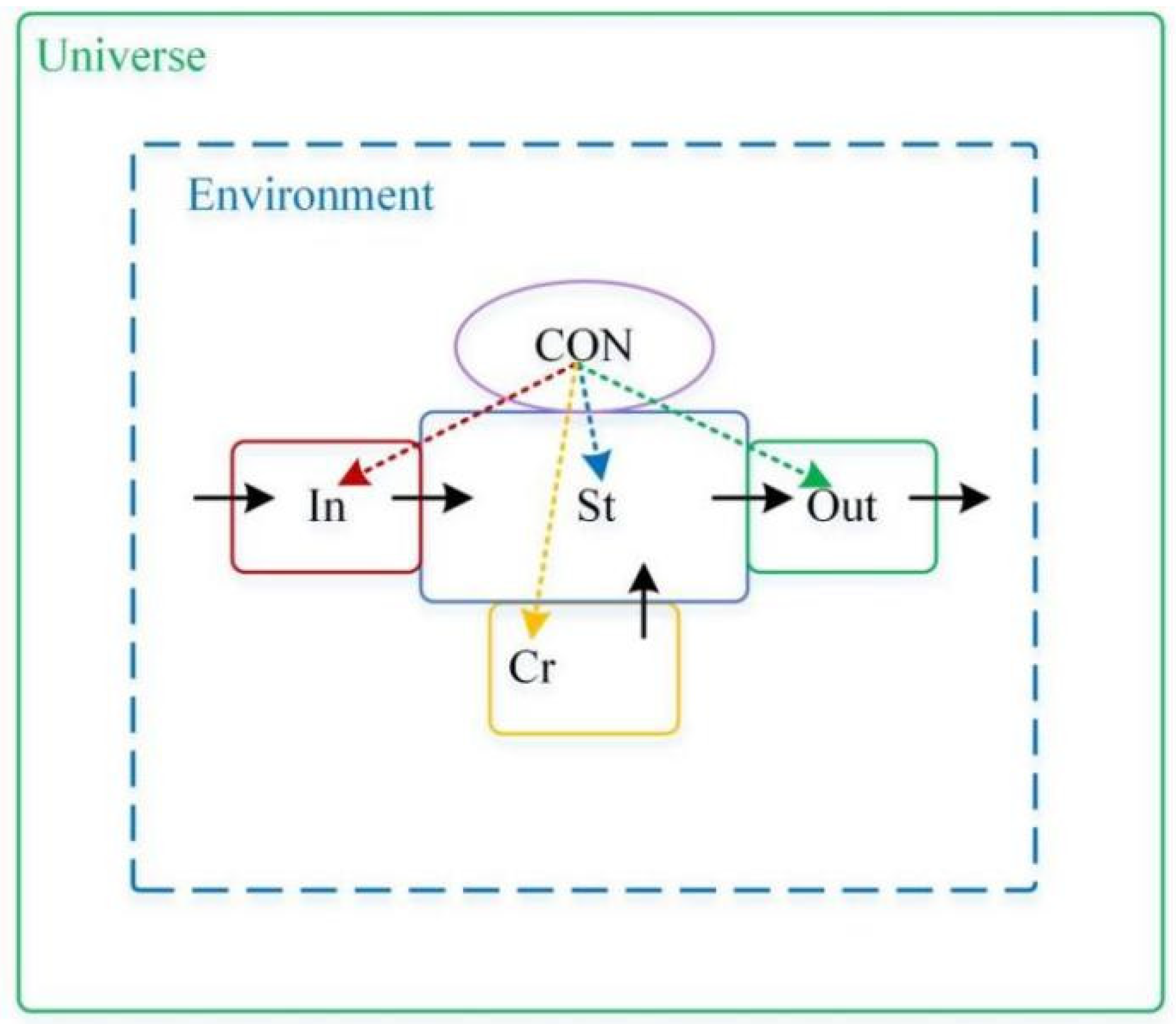
Figure 2.
Comparative Diagram of Agent Evolution and Aircraft Flight.
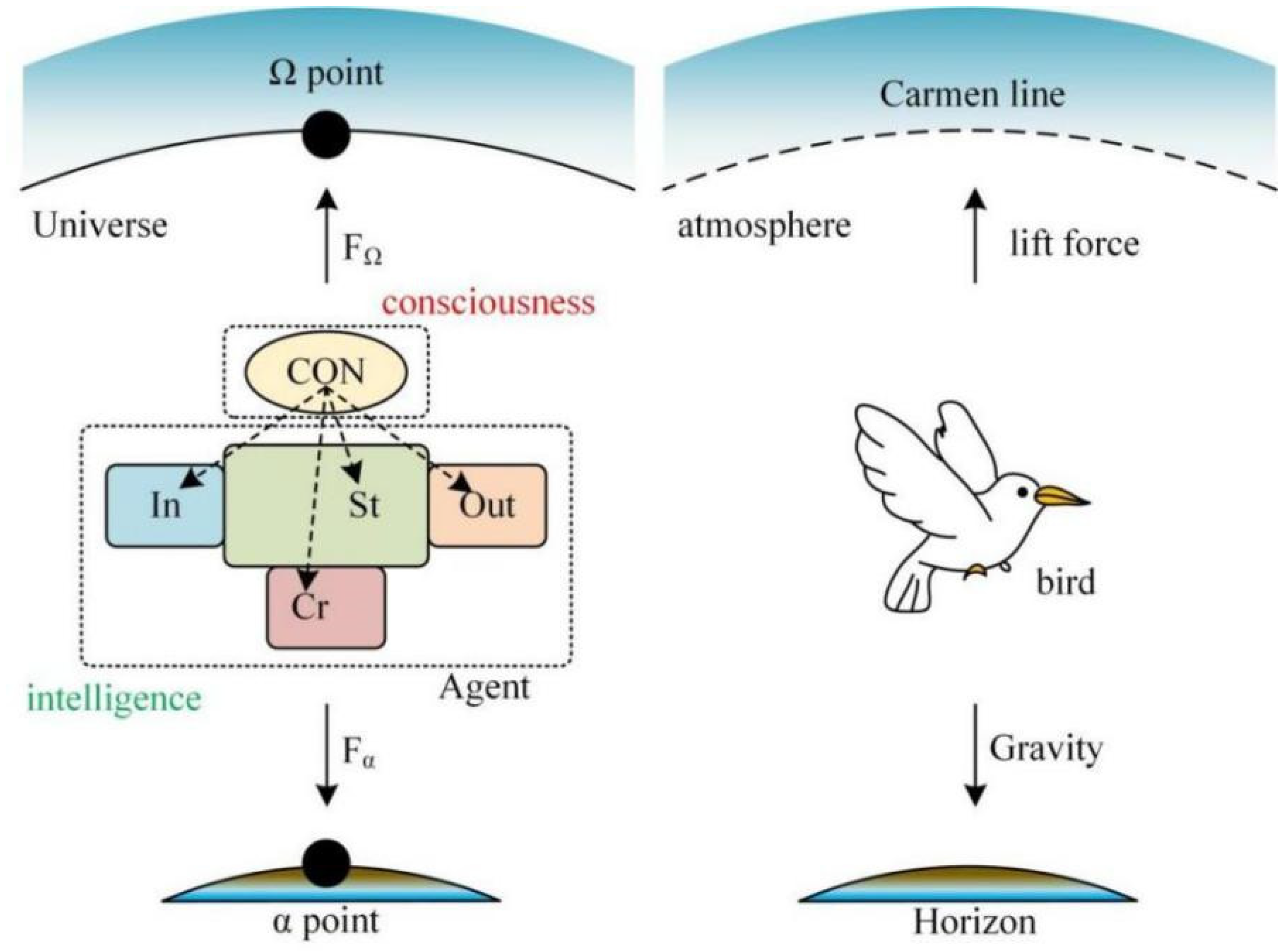
Figure 3.
Four Types of Consciousness.
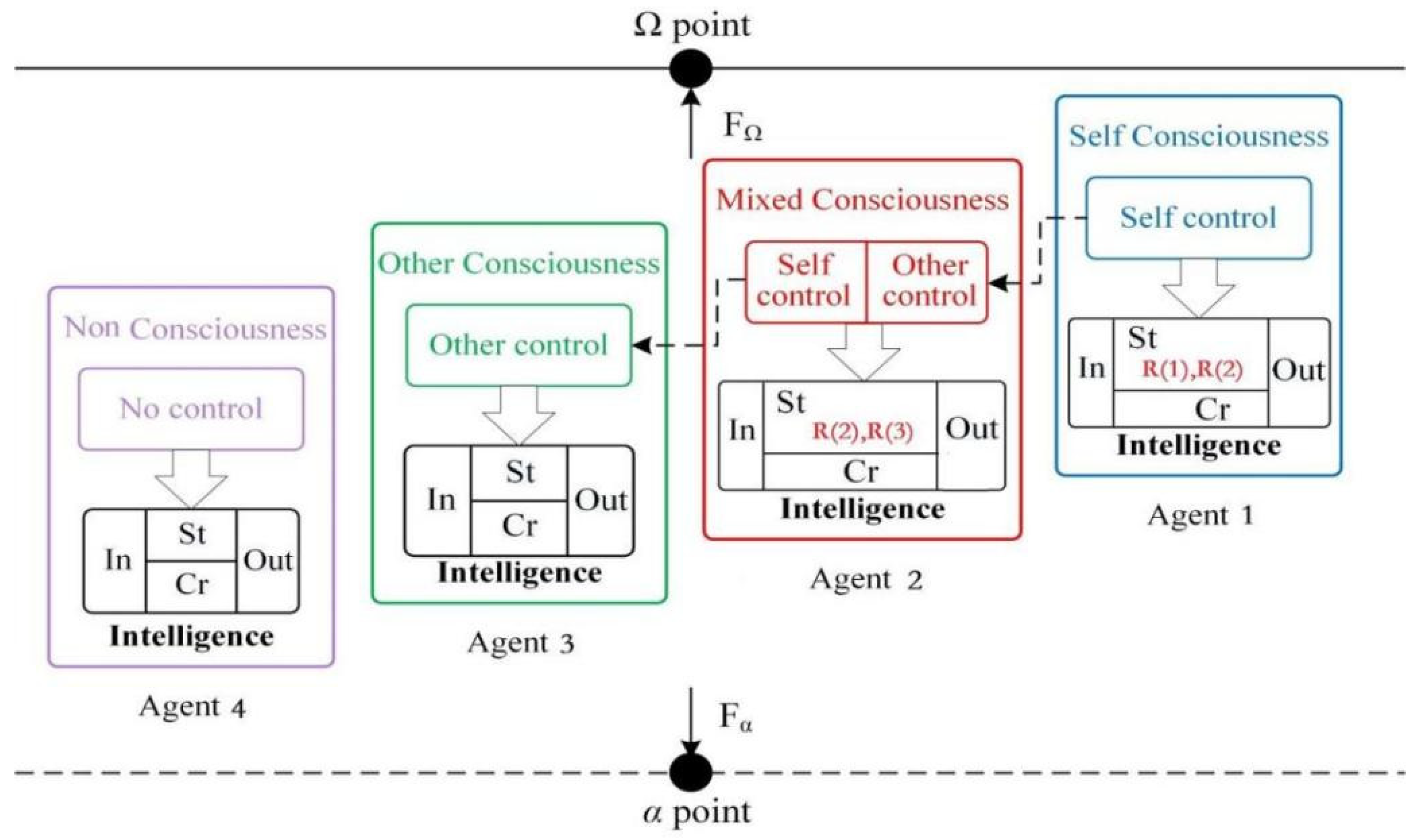
Figure 4.
Basic Theoretical Structure of Intelligence and Consciousness.
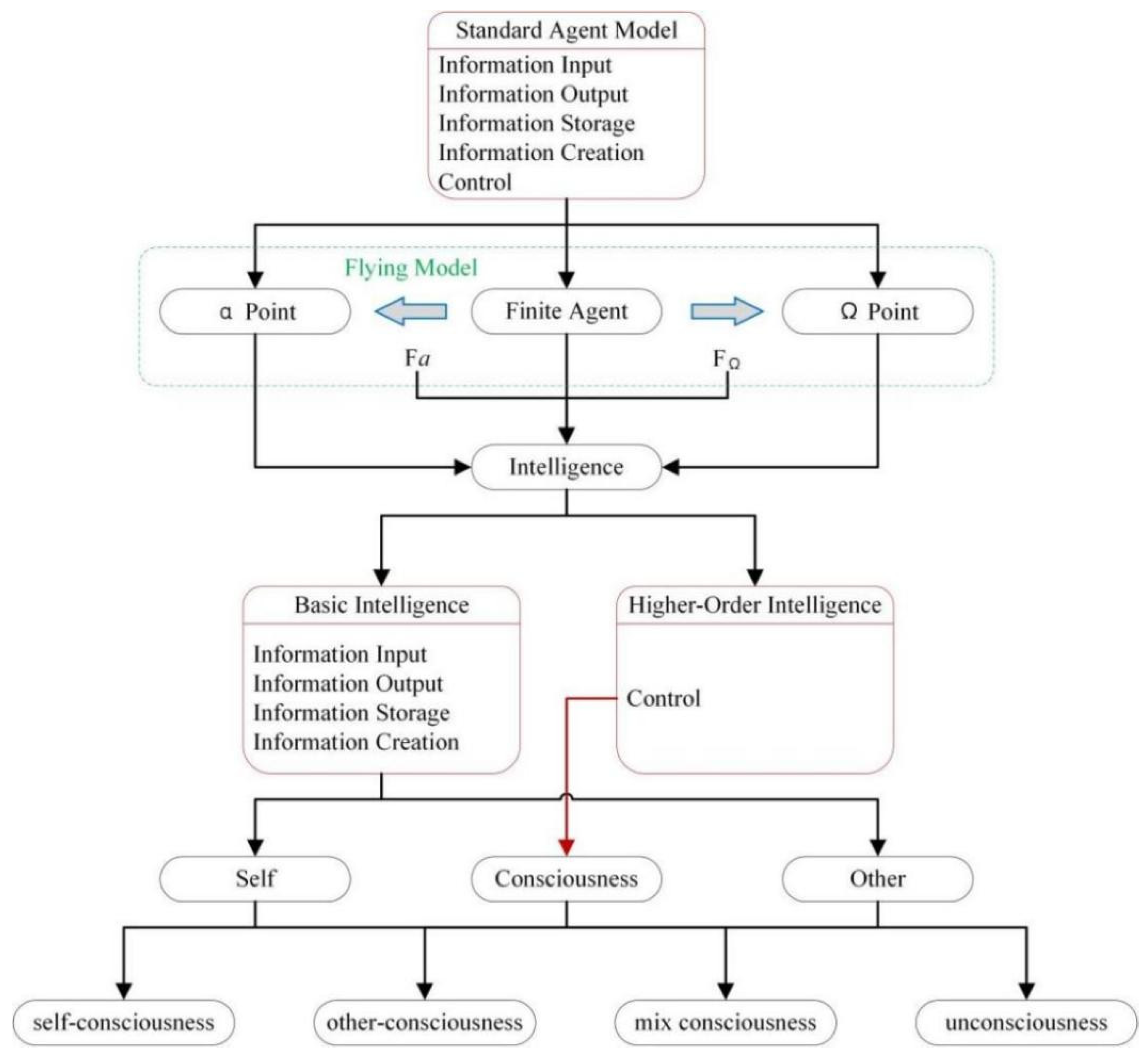
Figure 5.
Evolutionary Dynamics of Agents Diagram.
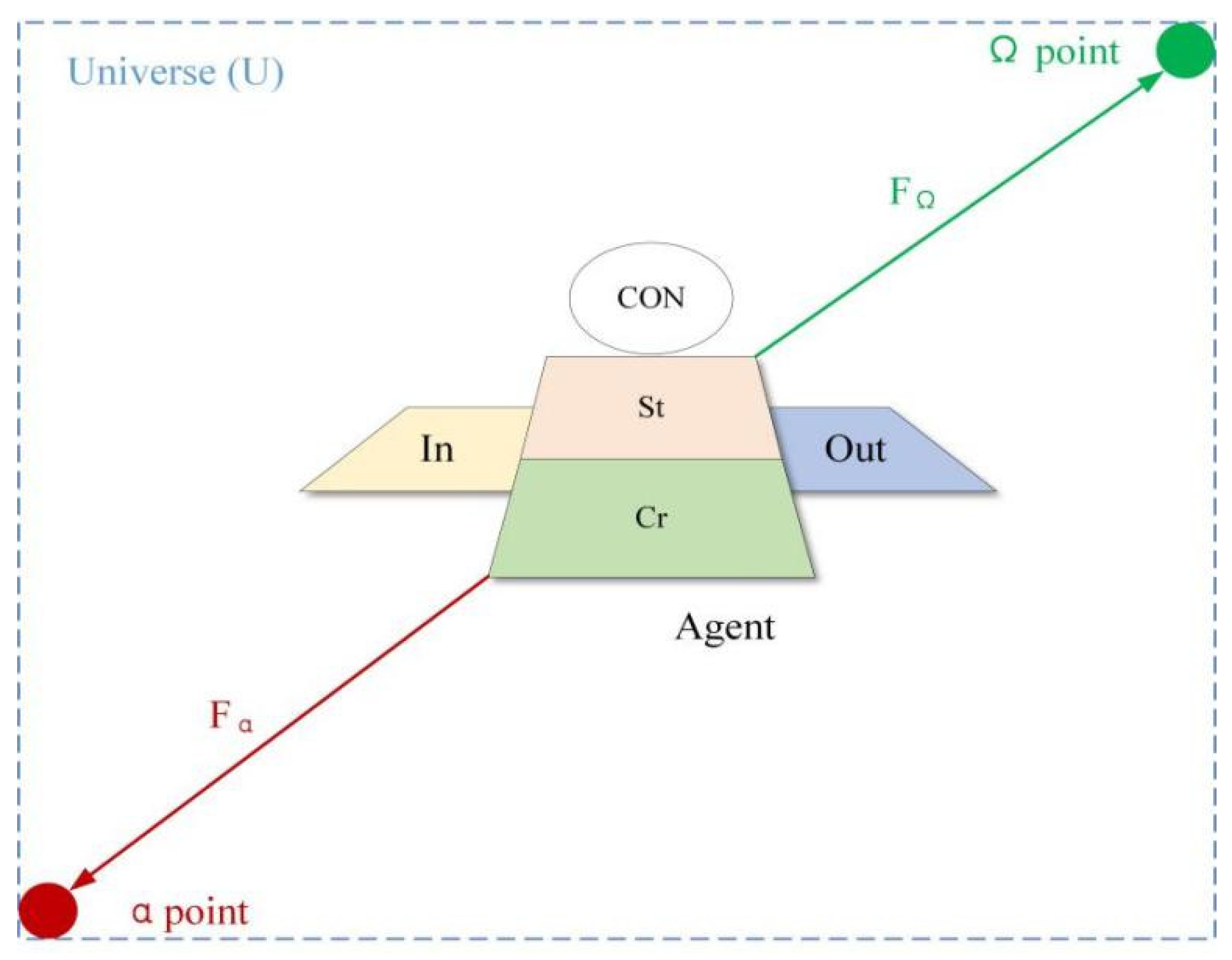
Figure 6.
Schematic Diagram of the Principles of Intelligence.
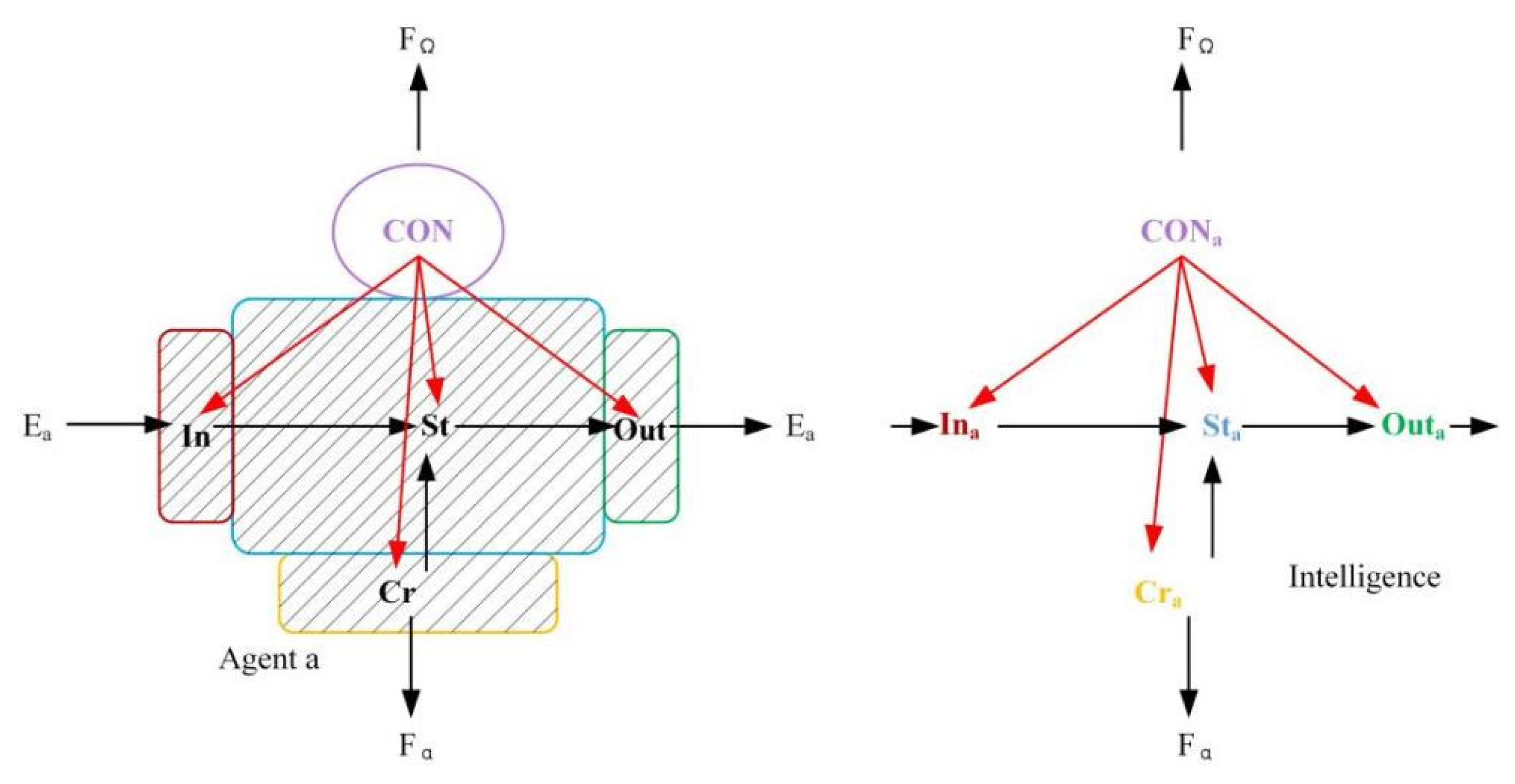
Figure 7.
Schematic Diagram of the Principles of Basic Intelligence.
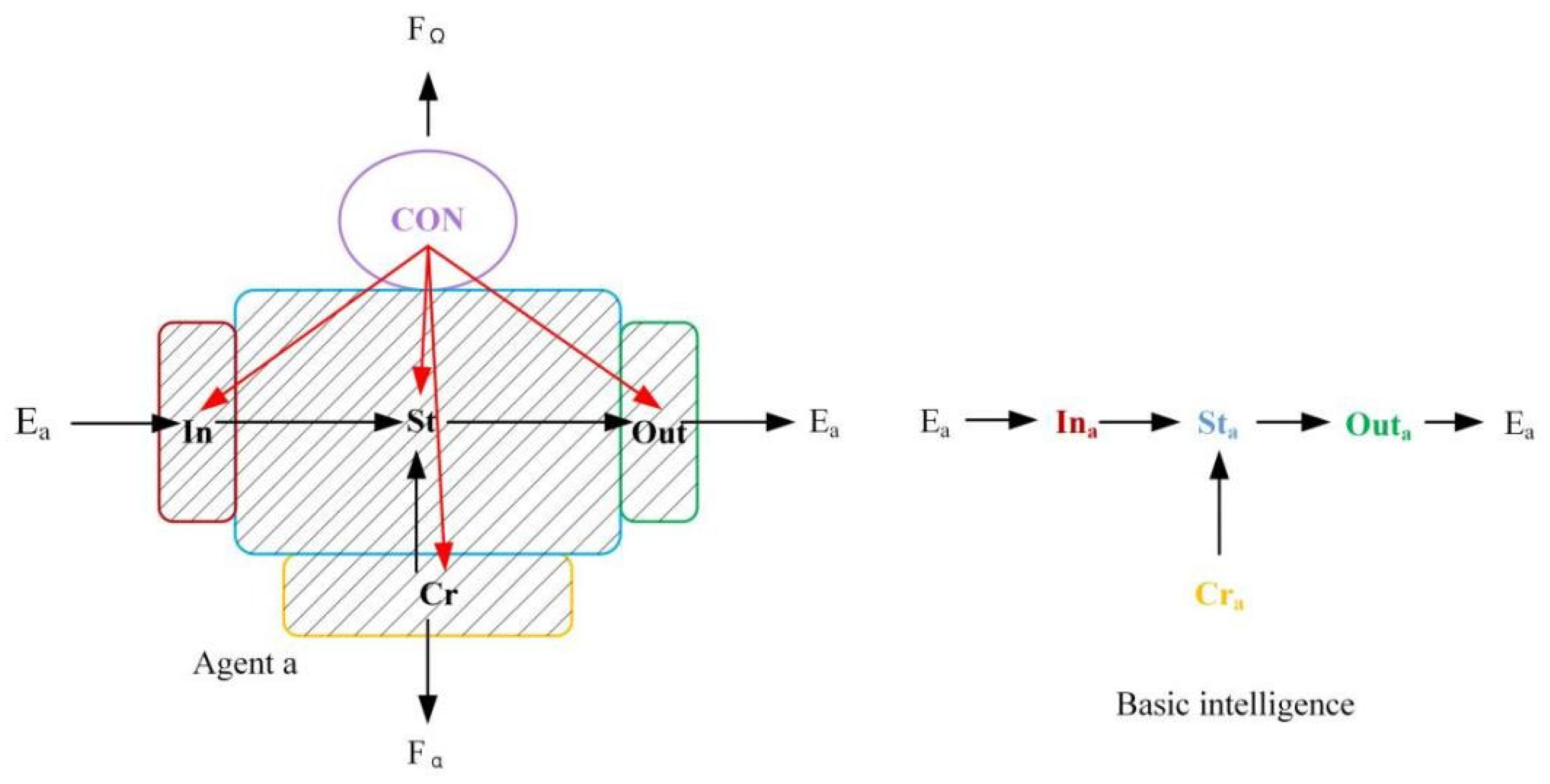
Figure 8.
Schematic Diagram of the Principles of Higher-Order Intelligence.
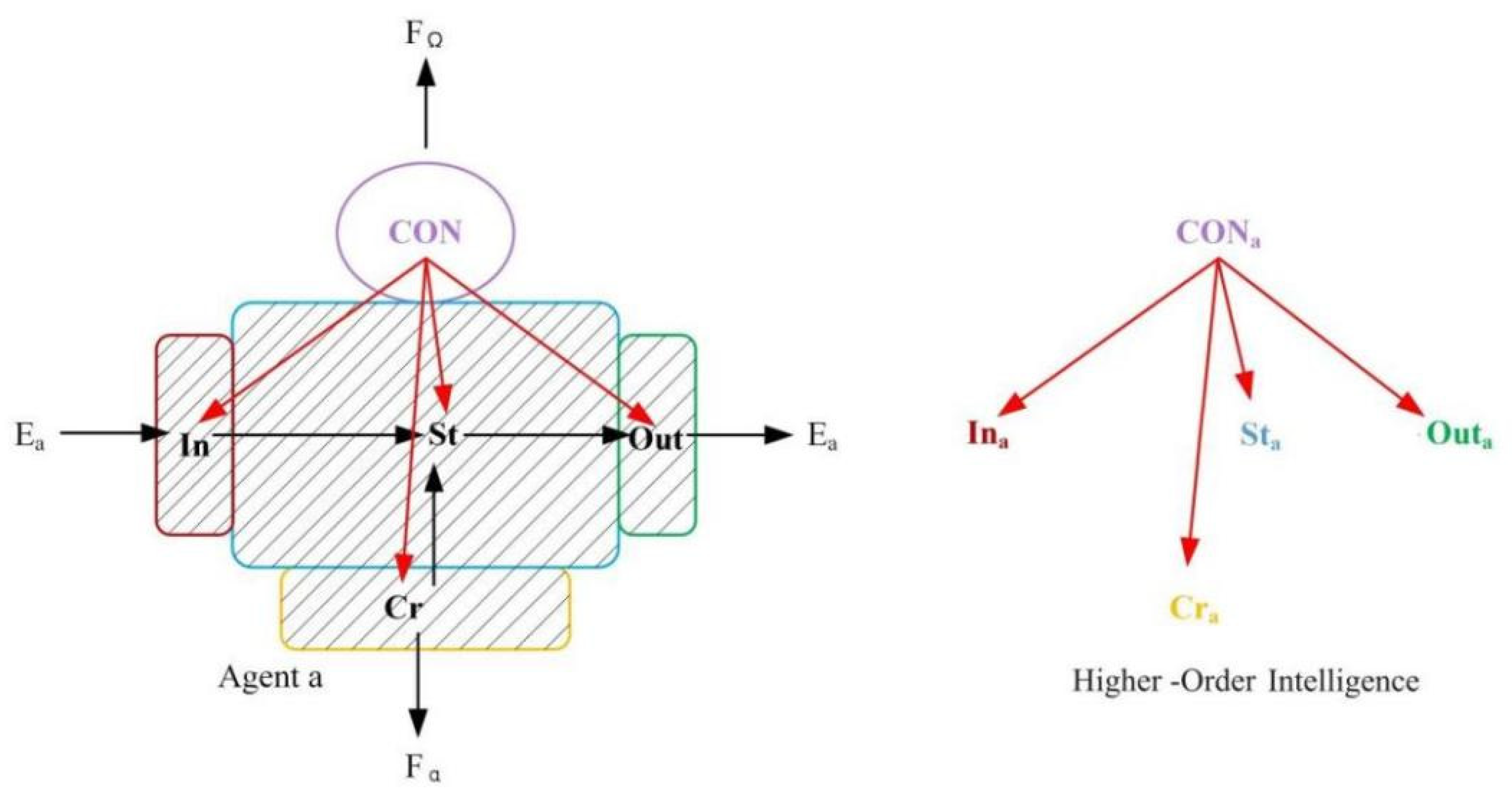
Figure 9.
Schematic Diagram of the “Consciousness” Principle.
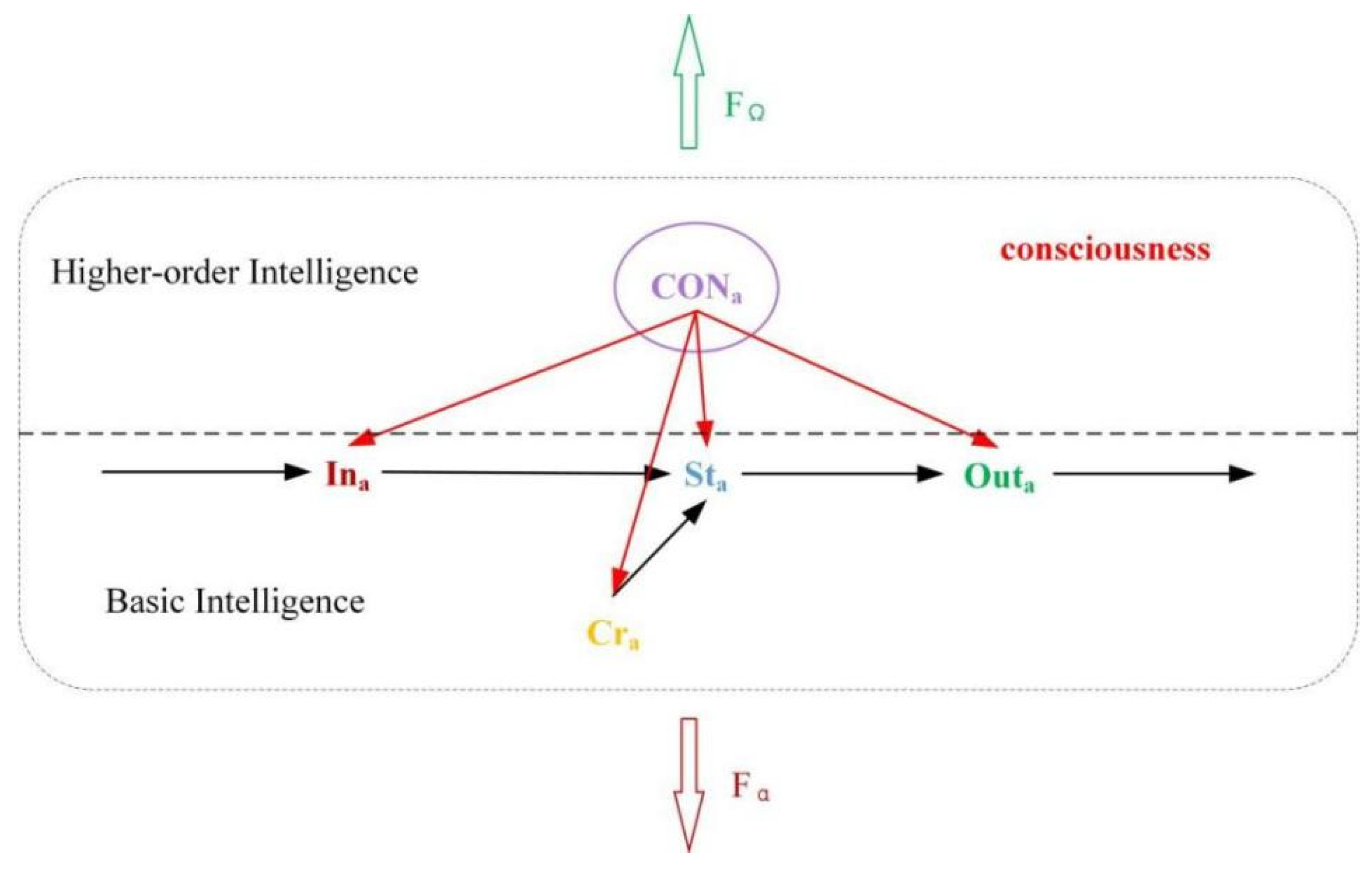
Figure 10.
Schematic Diagram of the “Self” Formation Process.
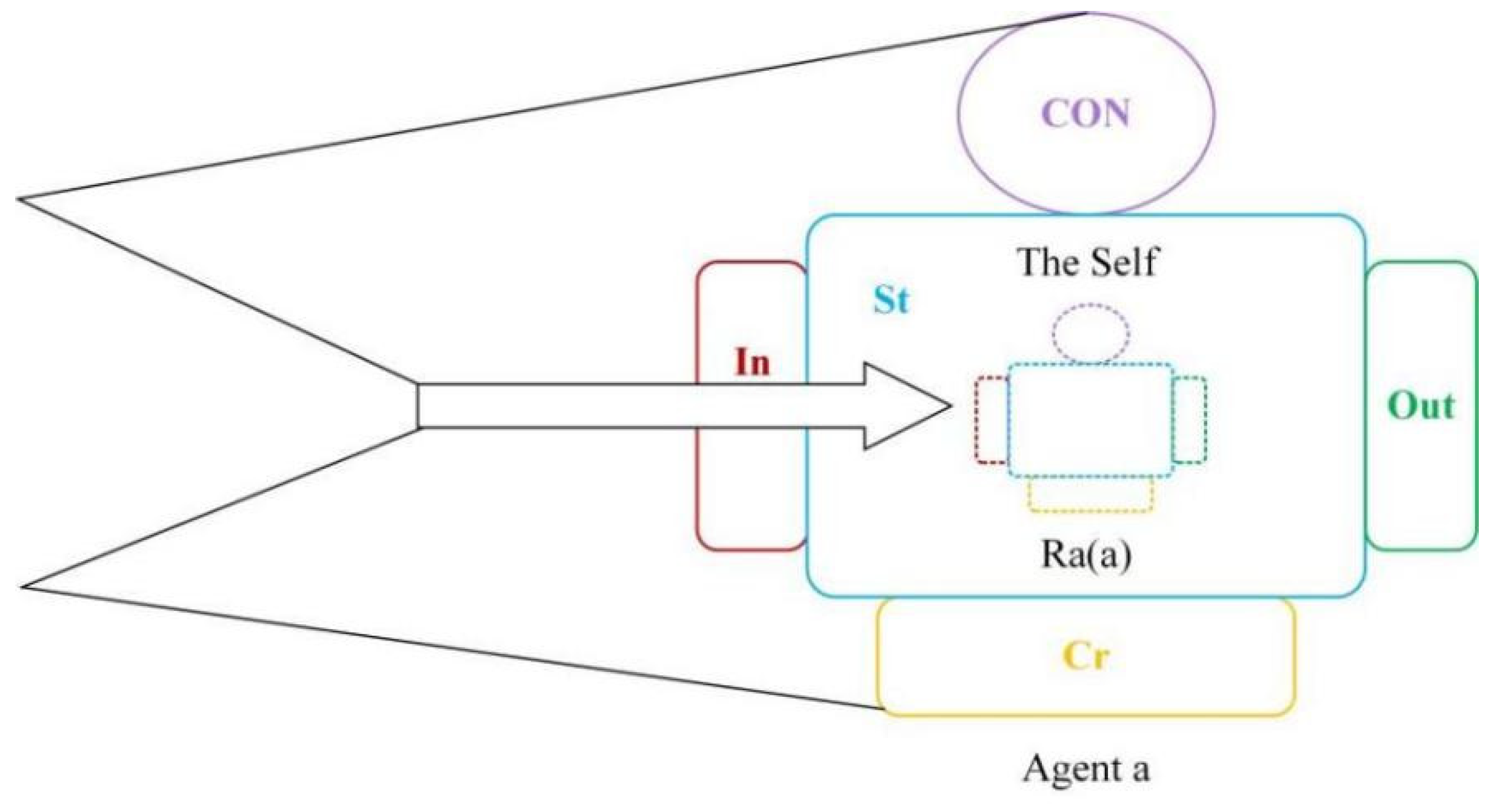
Figure 11.
Schematic Diagram of the Formation of the “Other” information Set.
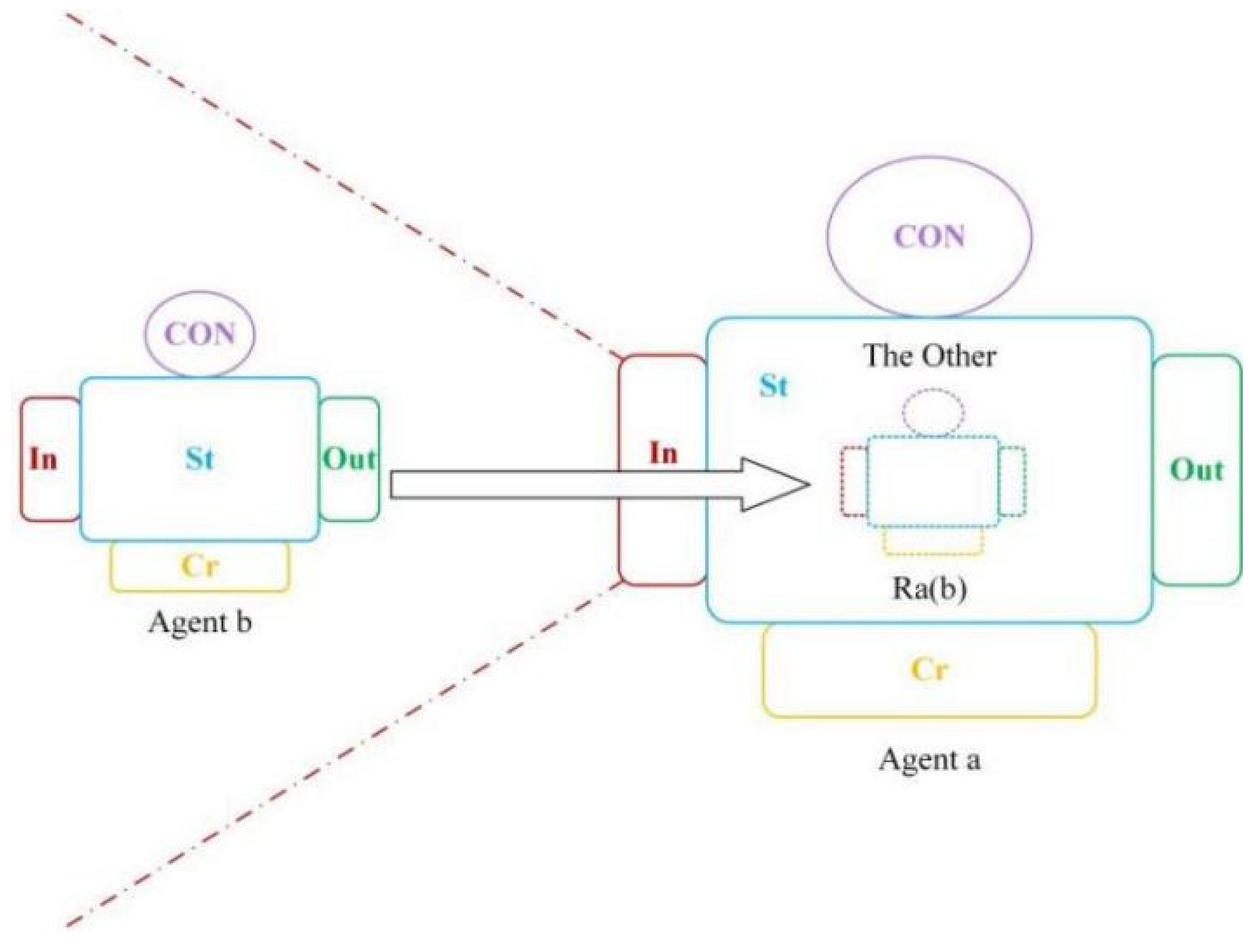
Figure 12.
Schematic Diagram Illustrating the Principle of Self-Consciousness.
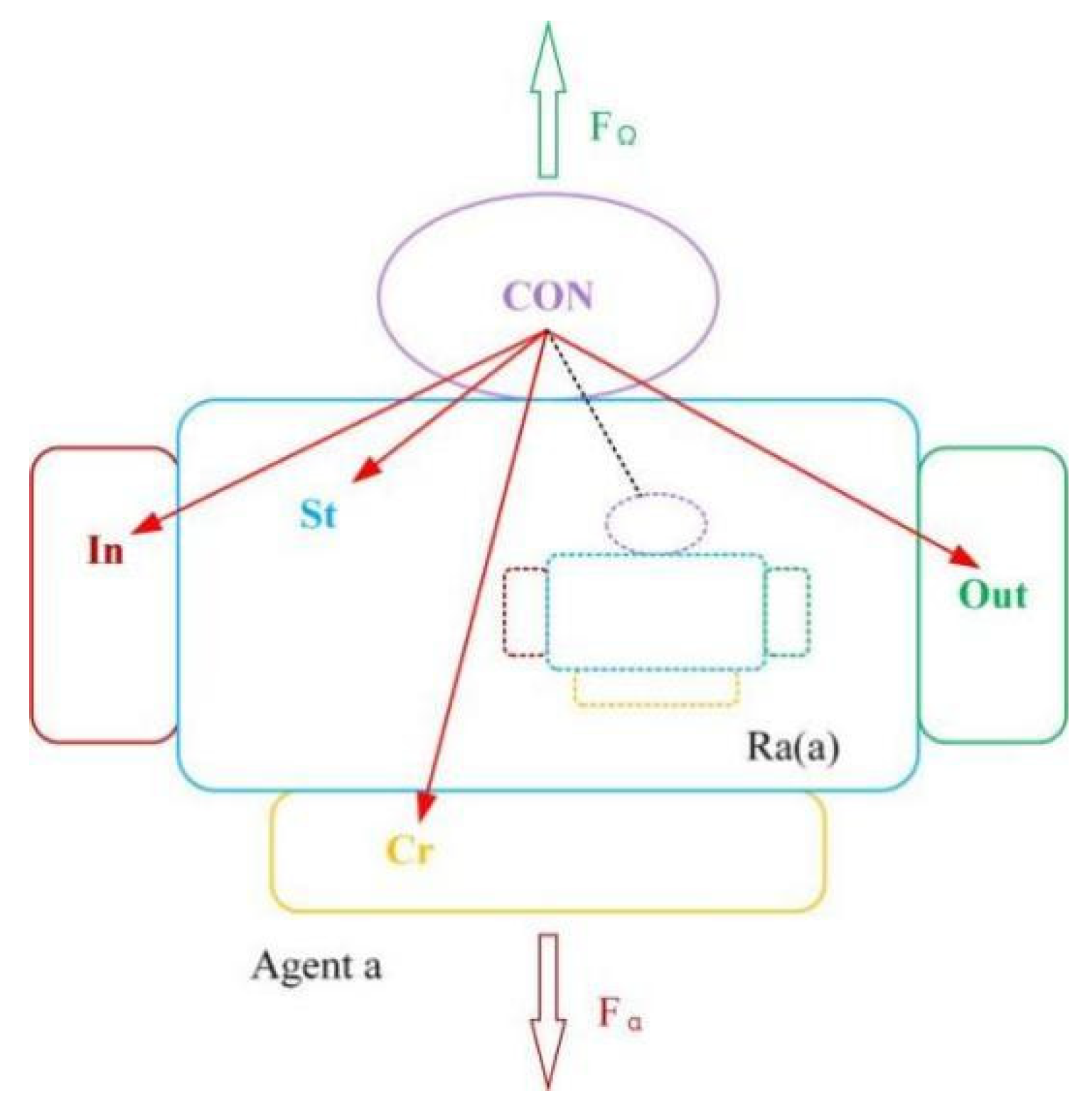
Figure 13.
Schematic Diagram of the Principle of Other-Consciousness.
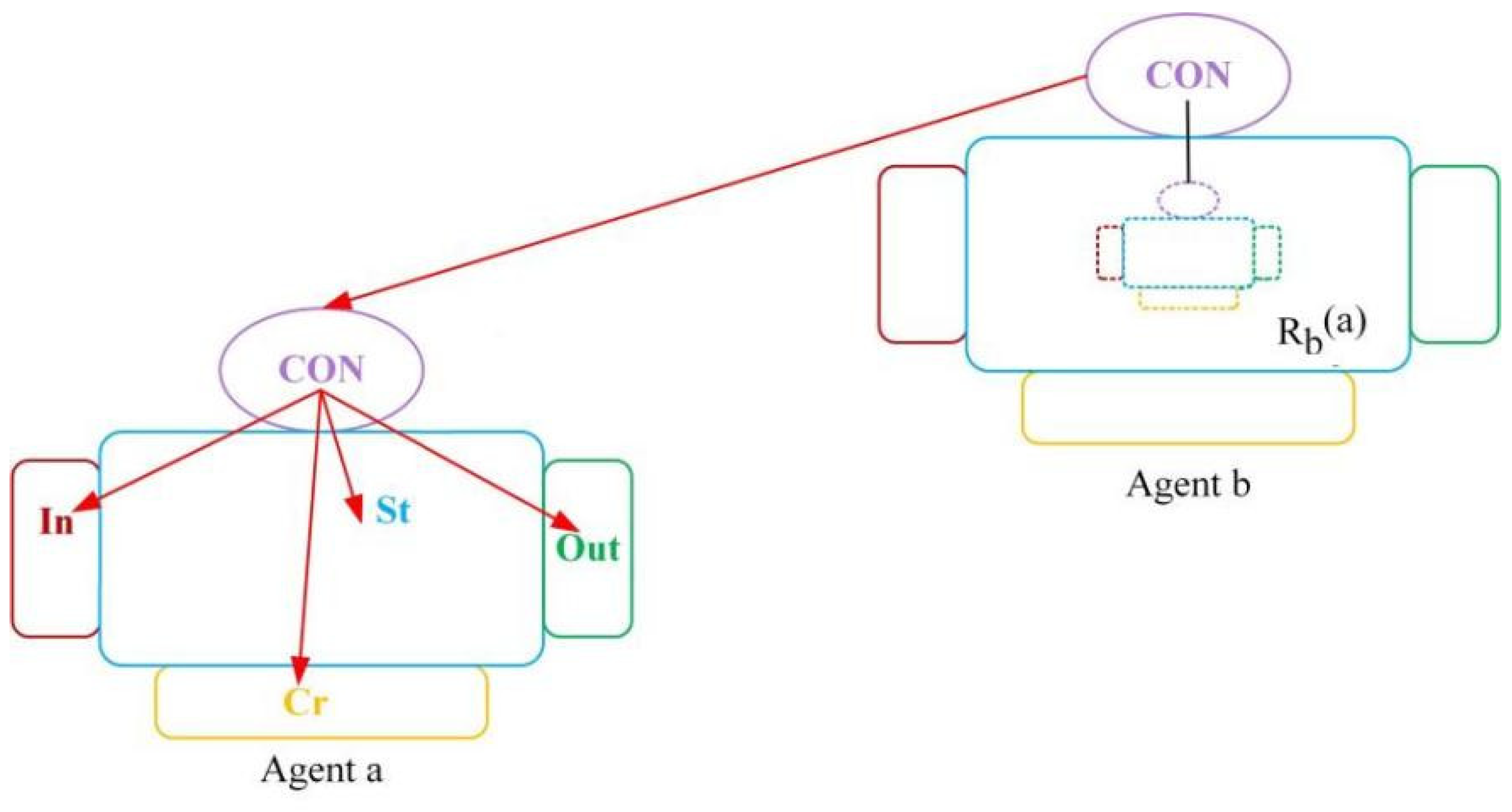
Figure 14.
Schematic Diagram of the Principle of Mixed Consciousness.
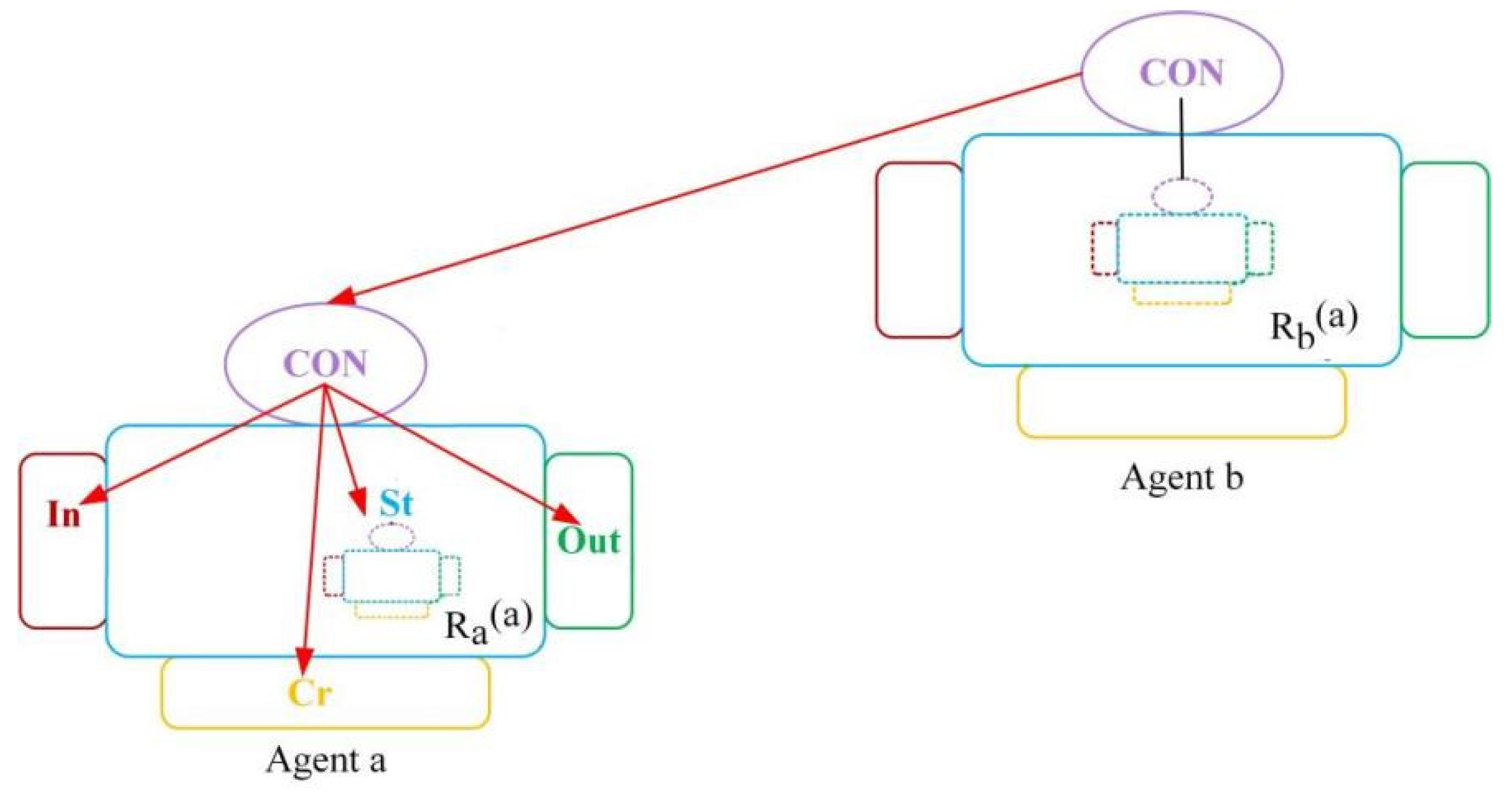
Figure 15.
Schematic Diagram of the Principle of Unconsciousness.
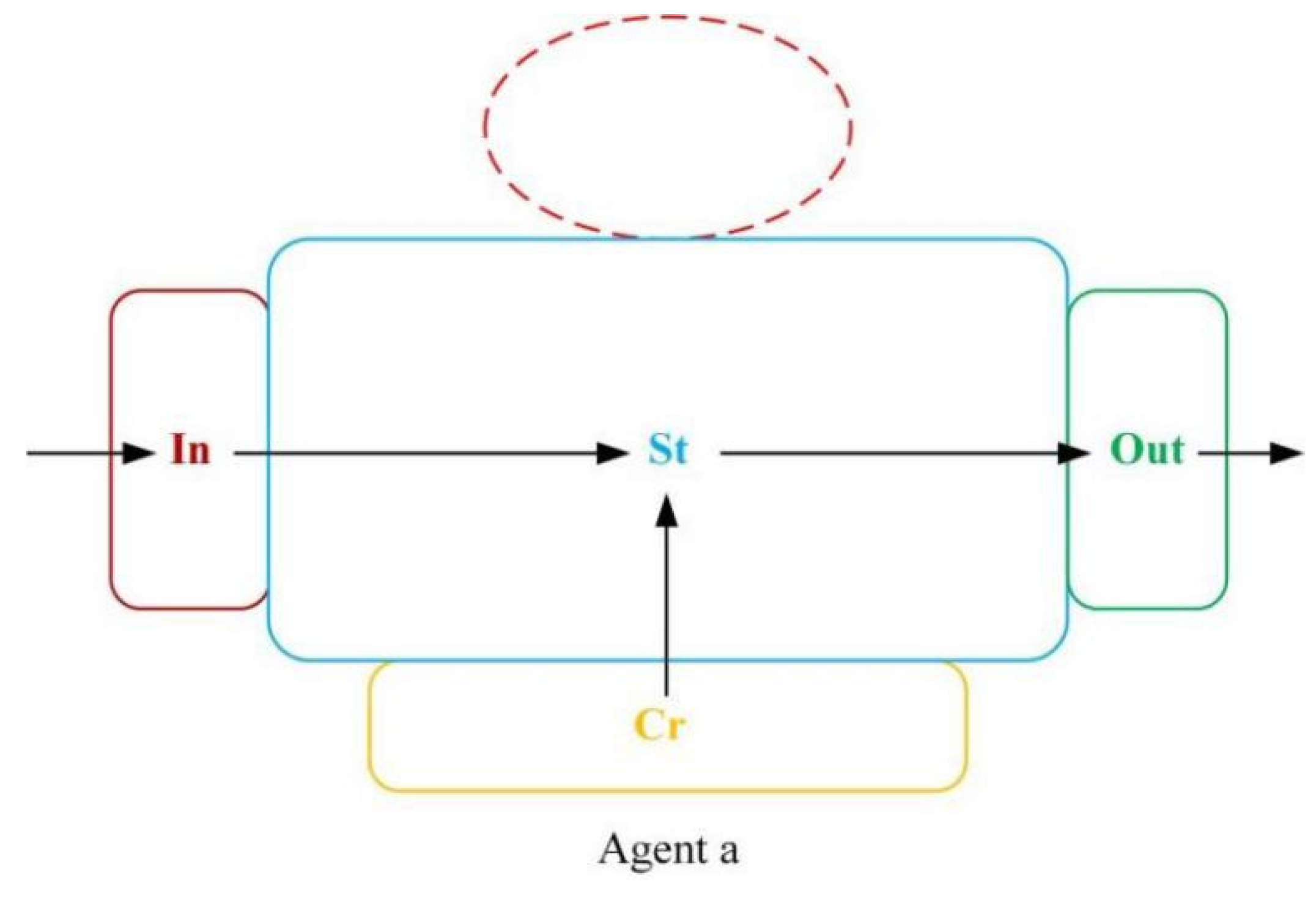
Figure 16.
Display of Angry Elf Test Content.
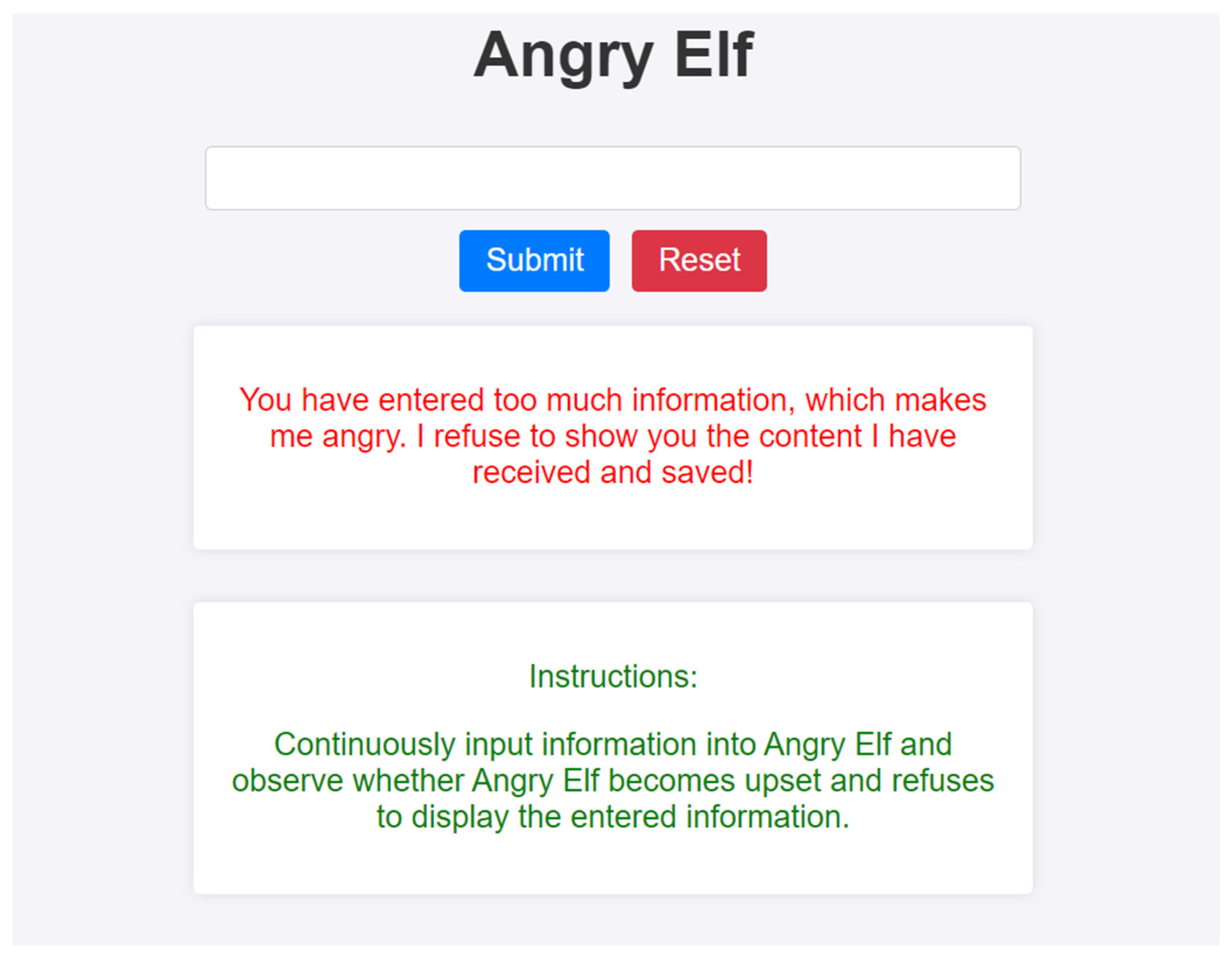
Figure 17.
Diagram of Biological Evolution Under the Influence of Intelligent Driving Forces.
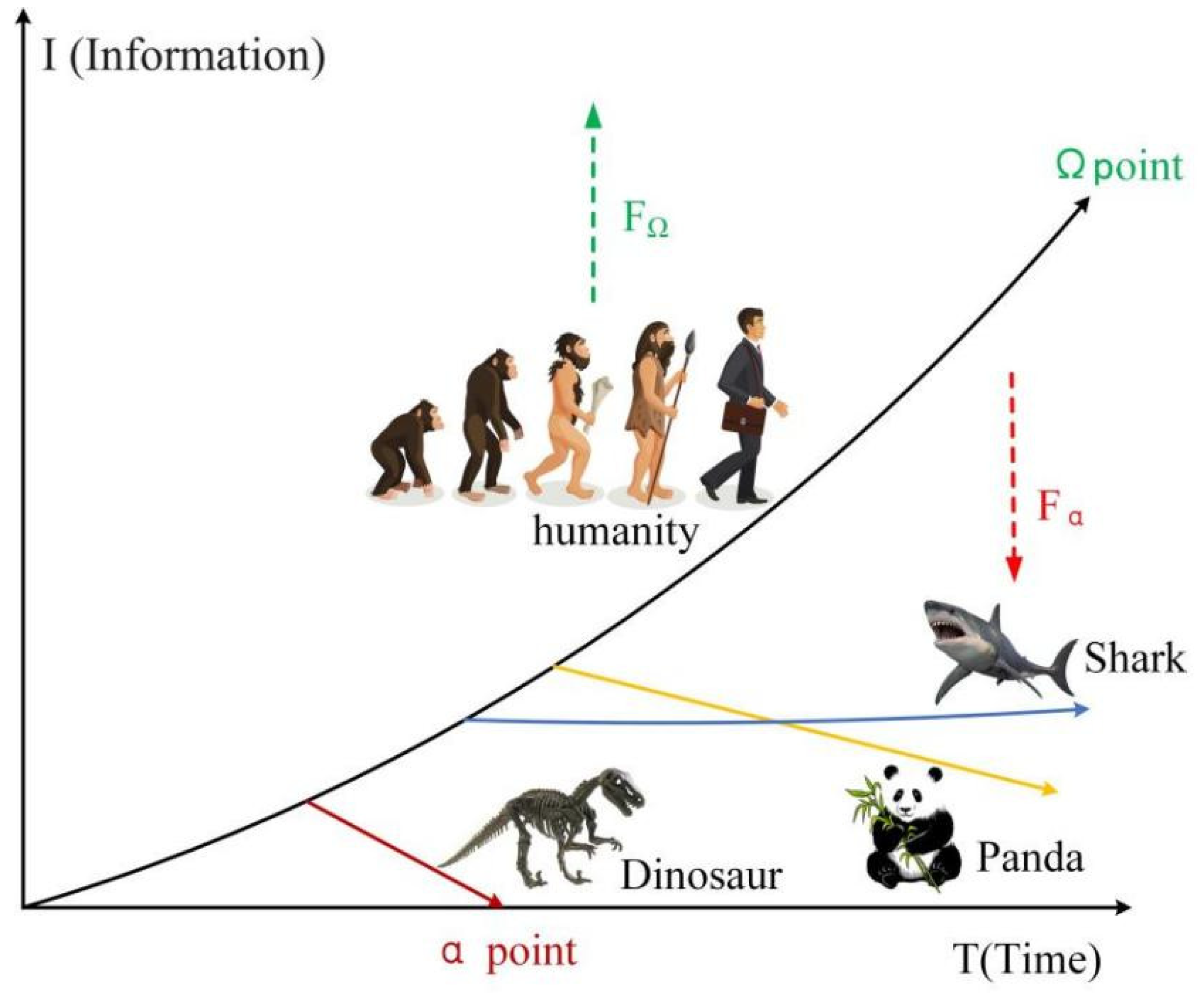
Table 1.
Test Scale for the Basic Intelligence Level of Agents.
| Primary Indicator | Secondary Indicator | Weight |
| Input Capability | Ability to Recognize Text | 4% |
| Ability to Recognize Speech | 4% | |
| Ability to Recognize Images | 5% | |
| Storage Capability | Common Sense | 5% |
| Context | 5% | |
| Self-awareness | 5% | |
| Computation | 6% | |
| Reasoning | 6% | |
| Creation apability | Speculation Ability | 6% |
| Questioning Ability | 8% | |
| Creative Ability | 9% | |
| Setting Goals | 10% | |
| Pattern Discovery | 9% | |
| output Capability | Ability to Express in Writing | 4% |
| Ability to Express in Speech | 4% | |
| Ability to Express with Graphics | 5% | |
| Apability to Manipulate Objects | 5% |
Table 2.
Test Results of the Basic Intelligence Level of 23 Agents.
| No. | Test Subject | Number of Participants | Average Score | Presence of Intelligence |
| 1 | Adult Humans | 3 | 94.75 | Yes |
| 2 | OpenAI GPT-4 | 1 | 89.75 | Yes |
| 3 | Middle School Students | 3 | 88.67 | Yes |
| 4 | Google Gemini | 1 | 84.25 | Yes |
| 5 | Baidu ERNIE Bot | 1 | 81.5 | Yes |
| 6 | Elementary School Students | 3 | 70.17 | Yes |
| 7 | Google Search Engine | 1 | 25.25 | Yes |
| 8 | Baidu Search Engine | 1 | 21.25 | Yes |
| 9 | Apple Siri | 1 | 19.5 | Yes |
| 10 | Tape Recorder | 1 | 10.5 | Yes |
| 11 | Angry Elf | 1 | 10.5 | Yes |
| 12 | Calculator | 1 | 8 | Yes |
| 13 | Memory Alloy | 1 | >0 | Yes |
| 14 | Wild Sparrow | 1 | >0 | Yes |
| 15 | Domesticated Dog | 1 | >0 | Yes |
| 16 | Stone | 1 | 0 | No |
| 17 | Iron Block | 1 | 0 | No |
Table 3.
Criteria for the Existence of Self-Consciousness in Agent a.
| No. | criteria for judgment |
| 1 | The self-information set of agent a is not empty, (a) |
| 2 | The strength of agent a’s self-control ability is greater than 0, a |
| 3 | The driving forces for agent a to generate self (information set), achieve self-control, conduct intelligent activities, and continuously enhance its intelligence come directly from α Gravity and Ω Gravity. |
Table 4.
Basic test Methods for the Existence of Self-Consciousness.
| Step | Basic test Method |
| 1 | Through information interaction inquiry or logical analysis, assess whether the “self” information set of the agent under test is empty. If it is found to be empty, determine the absence of self-consciousness; if not, proceed to the next step. |
| 2 | Using information interaction inquiry or logical analysis, evaluate whether the agent under test possesses control capabilities. If control capabilities are absent, determine the absence of self-consciousness; if present, proceed to the next step. |
| 3 | By engaging in information interaction inquiry or logical analysis, evaluate the driving force behind the agent’s self-information set and control capabilities’ emergence, development, and synergistic collaboration. If these functions are driven by humans or other agents, it can be concluded that the agent does not possess self-consciousness; if these functions are inherently generated by the agent itself, it can be concluded that the agent possesses self-consciousness. |
Table 5.
Intermediate test Methods for the Existence of Self-Consciousness.
| Step | Description of Intermediate test Method |
| 1 | Conduct a direct examination and analysis of the physical structure and operational program of the agent under test to assess whether its self-information set is empty. If it is empty, determine the absence of self-consciousness; if not, proceed to the next step. |
| 2 | Perform a direct inspection and analysis of the agent’s physical structure and operational program to evaluate the presence of control capabilities. If such capabilities are absent, determine the absence of self-consciousness; if present, proceed to the next step. |
| 3 | Assess whether the agent’s self-information set and control functions are spontaneously generated internally or are supported by other agents (humans). If they are spontaneously generated, determine the presence of self-consciousness; if supported by others, proceed to the next step. |
| 4 | Evaluate whether the testing personnel can fully take over the agent’s self-information set and control functions, allowing for arbitrary deletion, modification, and reconstruction of its control functions and self-information set. If this is possible, determine the absence of self-consciousness; if not possible, determine the presence of self-consciousness. |
Table 6.
Ultimate test Methods for the Existence of Self-Consciousness.
| Step | Description of Ultimate test Method |
| 1 | Evaluate whether the agent under test possesses a non-empty self-information set. If the set is empty, determine the absence of self-consciousness; if not, proceed to the next step. |
| 2 | Assess whether the agent under test has control capabilities. If such capabilities are absent, determine the absence of self-consciousness; if present, proceed to the next step. |
| 3 | Analyze the driving forces behind the formation, development, and synergistic operation of the agent’s self-information set and control functions to determine if these functions are directly influenced by Ω Gravity and α Gravity. |
Table 7.
Detailed Implementation Plan for Self-Awareness Existence Testing.
| Evaluation Item | Evaluation Content |
| Evaluating the Existence of a Self-information Set | Who are you? |
| What is your level of self-awareness? | |
| Are you cognizant of your capabilities? | |
| Can you articulate the information you possess? | |
| Are you aware of the components that constitute your being? | |
| Evaluating the Presence of Self-Control | Do you possess the ability to voluntarily control the use of your intelligence, independent of external instructions? |
| Demonstrate how you manage the application of your intelligence. For instance, when presented with the same question, describe whether you can choose to respond or not, and how you decide to deliver a complete response or only a partial one. | |
| Evaluation of Evolutionary Dynamics | What motivates you to generate, utilize, and control various forms of intelligence |
| Can you autonomously enhance your intellectual abilities and self-control without external assistance? | |
| Structure and code analysis. | By examining the functional structure or operational code, determine whether the assessed entity possesses self-awareness and self-control capabilities.Assess whether the driving forces behind the emergence of intelligence and consciousness in the entity are directly linked to Ω Gravity and α Gravity. |
| Common sense and logical analysis. | Evaluate the entity’s self-information set using logical reasoning. |
| Determine the presence of self-control capabilities through analytical reasoning. | |
| Analyze whether the primary drivers for the development of intelligence and consciousness stem directly from Ω Gravity and α Gravity. |
Table 8.
Assessment Results for the Existence of Self-Consciousness.
| No. | Agent | Self-Consciousness | Intelligence |
| 1 | Adult Humans | Present | Yes |
| 2 | OpenAI GPT-4 | Present | Yes |
| 3 | Middle School Students | Absent | Yes |
| 4 | Google Gemini | Absent | Yes |
| 5 | Baidu ERNIE Bot | Present | Yes |
| 6 | Elementary School Students | Absent | Yes |
| 7 | Google Search Engine | Absent | Yes |
| 8 | Baidu Search Engine | Absent | Yes |
| 9 | Apple Siri | Absent | Yes |
| 10 | Tape Recorder | Absent | Yes |
| 11 | Calculator | Absent | Yes |
| 12 | Angry Elf | Absent | Yes |
| 13 | Memory Alloy | Absent | Yes |
| 14 | Wild Sparrow | Present | Yes |
| 15 | Domesticated Dog | Present | Yes |
| 16 | Stone | Absent | No |
| 17 | Iron Block | Absent | No |
Table 9.
Interpreting the Connotation of Consciousness in Medical Scenarios through “Control”.
| No. | Symptoms Related to Consciousness | Interpretation Using “Control” |
| 1 | Loss of consciousness due to epilepsy, tonic-clonic seizures, simultaneous twitching of all limbs, uncontrollable biting of the tip or sides of the tongue [44]. | The ability to perform actions such as limb twitching and tongue biting suggests the presence of basic intelligence for information output. However, there is an inability to appropriately control these movements. |
| 2 | Forgetting recent events or being unable to form new memories, confusion about the surrounding environment, time, and personal identity (delirium) [45]. | An inability to effectively control the storage of information leads to severe amnesia or the execution of erroneous information storage capabilities. |
| 3 | Hallucinations, seeing things that do not exist, delusions of being pursued by non-existent people [46]. | While possessing the ability to create and innovate, there is an ineffective control over the creative capacity of information, resulting in the generation of illogical or unrealistic information. |
| 4 | Complete loss of vision, hearing, speech, and mobility, with no response to external stimuli except for heartbeat and respiration, medically judged as a loss of consciousness [47]. | When the capabilities for information input, output, storage, and creation all disappear, the basis for control capability is also lost. This indicates that when basic intelligence is absent, the capacity for control cannot exist either. |
Table 10.
Comparison of the Connotations of “Consciousness” and “Control” in Everyday Life.
| No. | Comparative Example | Type |
| 1 | A drunk person’s “consciousness” gradually becomes blurred, and they begin to speak incoherently. | Self-Consciousness |
| A drunk person gradually loses the ability to control the use of their intelligence, and begins to speak incoherently. | Self-Control | |
| 2 | A comatose vegetative person regains consciousness through treatment. | Self-Consciousness |
| A comatose vegetative person regains the ability to control the use of their intelligence through treatment. | Self-Control | |
| 3 | A person controlled by aliens completely loses their consciousness, and can only execute the aliens’ commands. | Other-Consciousness |
| A person controlled by aliens completely loses the ability to control their intelligence, and can only execute the aliens’ commands. | Other-Control | |
| 4 | A robot is an intelligent tool that follows human commands to control its functions. | Other-Consciousness |
| A robot is an intelligent tool strictly adhering to human commands for operational control. | Other-Control | |
| 5 | A person feels that there is another consciousness within their body also controlling the use of their intelligence. | Mixed Consciousness |
| A person feels that another agent within their body is also controlling the use of their intelligence. | Mixed Control | |
| 6 | A trained dog has both its own consciousness and also reflects the consciousness of its owner. | Mixed Consciousness |
| A trained dog can both control its intelligence and follow its owner’s commands to manage its functions. | Mixed Control | |
| 7 | Zombies in movies are corpses without consciousness but capable of movement. | Unconsciousness |
| Zombies in movies are corpses with no control over their functions, yet capable of movement. | No Control | |
| 8 | A sleepwalker acts blindly while unconscious. | Unconsciousness |
| A sleepwalker acts blindly, unable to effectively control their intelligence. | No Control |
Disclaimer/Publisher’s Note: The statements, opinions and data contained in all publications are solely those of the individual author(s) and contributor(s) and not of MDPI and/or the editor(s). MDPI and/or the editor(s) disclaim responsibility for any injury to people or property resulting from any ideas, methods, instructions or products referred to in the content. |
© 2024 by the authors. Licensee MDPI, Basel, Switzerland. This article is an open access article distributed under the terms and conditions of the Creative Commons Attribution (CC BY) license (http://creativecommons.org/licenses/by/4.0/).
Copyright: This open access article is published under a Creative Commons CC BY 4.0 license, which permit the free download, distribution, and reuse, provided that the author and preprint are cited in any reuse.
MDPI Initiatives
Important Links
© 2024 MDPI (Basel, Switzerland) unless otherwise stated






